The Synology DS723+ NAS Review – Tremendous 2-Bay?
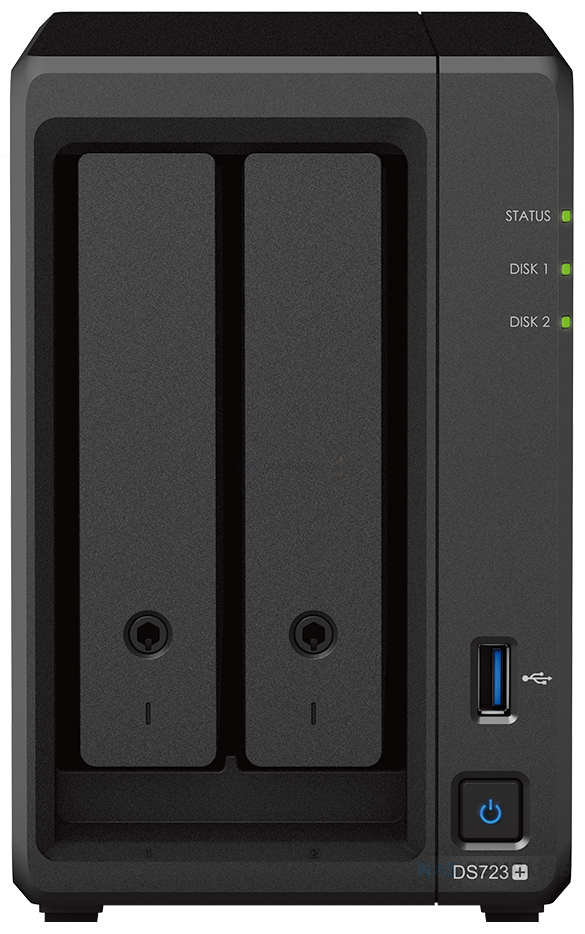
Synology has always maintained a remarkably envious position in the NAS industry over the last decade or so. Although they didn’t ‘invent’ the idea of a private server in the home/office, they were the first to give the concept a fantastically consumer and accessible presentation. Over that time we have seen their popular Diskstation series go from strength to strength, with this new DS723+ NAS 2-Bay being the latest to join their growing lineup. All this said, the landscape has changed somewhat and with a vastly more informed and hardware-aware audience is not quite as optionless as it once was. Despite Synology’s top-tier platform ‘DSM’ still setting the standard for NAS software, the brand has come under growing criticism for their hardware choices. The DS723+ is the latest offering from the brand that hopes to challenge this reputation of software over hardware, providing a number of key improvements to the modest 2-Bay tier, such as ECC memory and optional network upgradability. Arranging as effectively HALF of the DS923+ NAS in most ways (but crucially, not half the price due to DSM being the main selling point), will the DS723+ NAS simply serve to upto the 4-Bay, or does it present itself as the perfect high powered and high-speed compact solution for those larger HDD capacities arriving in 2022 (20TB, 22TB and 26TB by the end of the year)? Let’s find out in my review of the Synology DS723+ NAS.
Synology DS723+ NAS Review – Quick Conclusion
There is no denying that the Synology DS723+ NAS is the most powerful, capable and upgradable 2-Bay that Synology has EVER released. Although the AMD Ryzen dual core Ryzen CPU is going to be a sticking point for those who wish a quad-core and/or integrated graphics CPU had been used (eg video conversions server side in Plex and the like) – the capabilities of the DS723+ NAS in it’s traditional performance, handling and throughput are better than they have ever been on ANY other Synology 2-Bay before. The 10GbE optional upgrade on this system is a very welcome but surprisingly option on this device (given Synology’s past reluctance to prove this on a system that may well struggle to saturate it with just two bays). Then there is the support of M.2 NVMe SSD storage pools, making the DS723+ NAS just the 2nd every Synology NAS to support this function (alongside SSD cache support of course) – though odd decisions on Gen 3×4>3×1 handling are still a touch puzzling. Support of DSM 7.1 (DSM 7.2 beta soon, at time of writing) runs beautifully on the DS723+ NAS and is still clearly what the primary selling point of this system is, with Synology offering the system as a solution and entry point into their ecosystem, rather than a hardware/nuts-and-bolts purchase. The full range of 1st party tools (Active backup, VMM, Photos, Drive, Collaboration Suite, Hyper Backup, Surveillance Station and more) still continue to impress and to have full and (mostly) licence-free access to these from such a compact server system is genuinely fantastic. Likewise, the support of 3rd party client applications and SaaS/PaaS services (Google WorkSpace, Office 365, VMware, Hyper-V, etc) still maintains a high standard of integration with the Synology tools, though with a clear growing movement by the brand to prioritize it’s own services.
Still, there is a lingering feeling that the DS723+ NAS in it’s default state is crying for a defacto day one upgrade. The 2GB of base memory seems rather penny-pinching, despite the support of ECC. The 10GbE upgrade option is welcome, but largely inevitable when the default connection are 1GBe – IN 2023! I return to my point at the intro, where there DS723+ arrives (at least in terms of hardware) as practically half of the DS923+ (half the bays, half the memory, half the USBs, etc), but with a pricepoint that is certainly not half. Therefore in many ways, the DS723+ NAS serves as a compelling argument to just skip it entirely and go for the DS923+ for about £200 more and enjoy those extras and partially populate. The support and compatibility of 3rd party hardware on the DS723+ NAS is a fraction more streamlined than some might like (eg 22TB and 20TB HDDs still remain absent on the compatibility list, yet Synology branded 18TB drives are clearly available and we absent upto that point despite WD and Seagate NAS alternatives in the market), but overall the DS723+ is still a great NAS and easily cements itself as the best 2 bay offering by the brand in their 20+ year history.
Where to Buy a Product





![]()
![]()

VISIT RETAILER ➤






![]()
![]()

VISIT RETAILER ➤






![]()
![]()

VISIT RETAILER ➤






![]()
![]()

VISIT RETAILER ➤
Synology DS723+ NAS Review – Presentation & Packaging
I won’t spend too long talking about the external packaging of the Synology DS723+ NAS, as it is remarkably similar to that of other Diskstation devices at this scale. The presentation of the retail box does have more attention to detail than you might expect though (given this is a 99% online purchased device and therefore any kind of glossy/detailed livery is almost a vanity addition!), as alongside the expected Synology logo and sticker for the model ID, the box is printed with tonnes of devices specific details. Synology has always been very, VERY aware of the power of branding with their solutions, as its little details like these (as well as embossed handles and favouring solution/every-man related terminology over cold specifications on the packaging) go a long way to set them apart from the sea of brown-box-rinse-repeat found in most online IT solutions you buy online and not at retail.
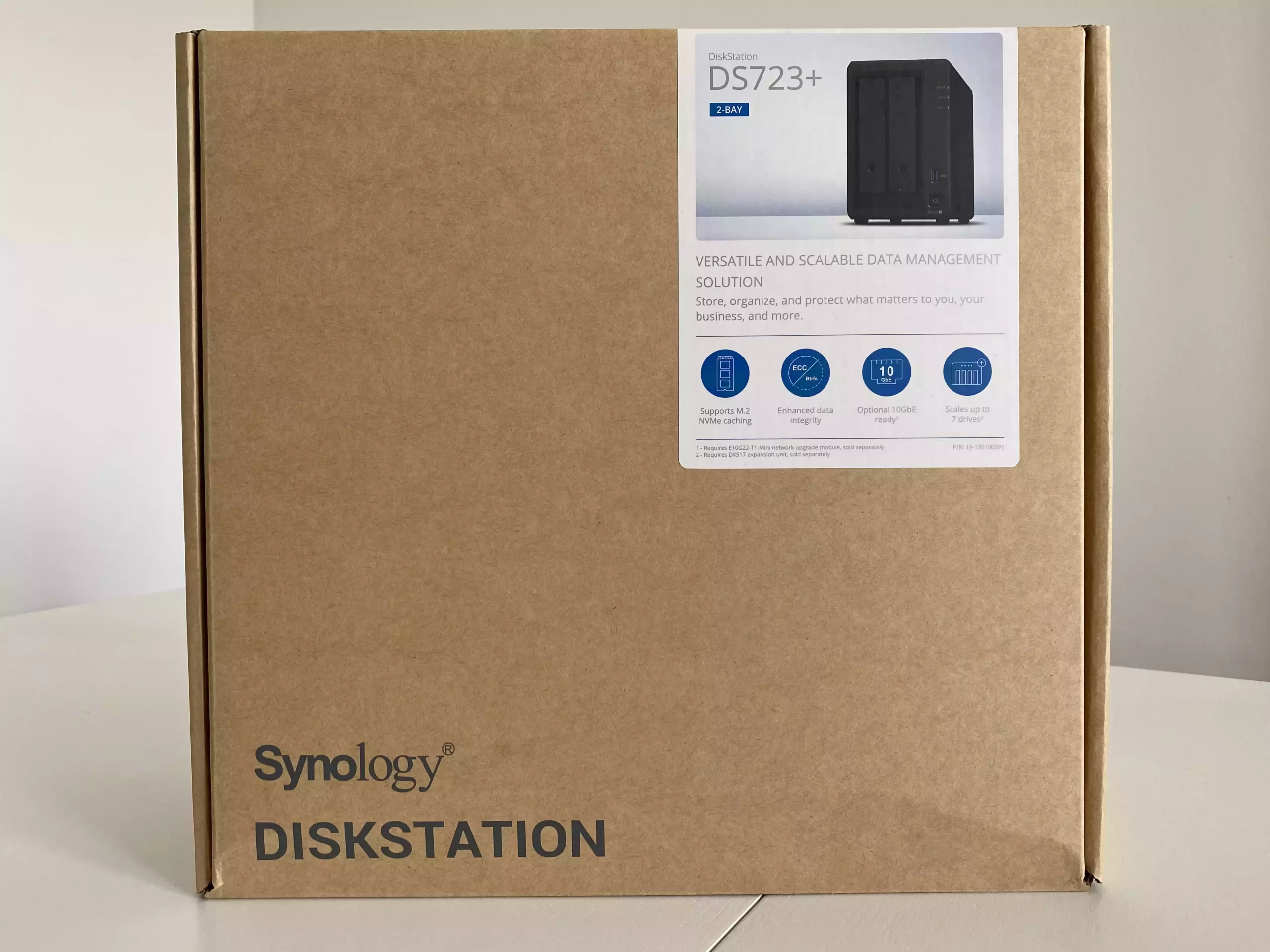
Despite the fact the DS723+ NAS is shipped unpopulated from Synology, we still need to grade/review them on the protection this unit is afforded in transit. As solid as a lot of IT kit looks, you cannot ignore the effects of shock or motion damage on them in long-distance travel from their point of manufacture (Taiwan in this case), so I will always give a brand extra points if they have gone the extra mile to spend a little more on protecting their system. In the case of the Synology DS723+ NAS, it’s mostly ok. I wish they used more hard foam/surrounding as you find in their 6-Bays and higher solutions (DS1621+, DS1821+, etc), as the DS723+ NAS arrives in a mostly cardboard structure that I think will be fine for the most part, but wouldn’t stand up to physical pressure tremendously well. Everything is separated very well and the structure/framework is there, it is just mostly cardboard! But I am being a bit petty here… let’s move on!
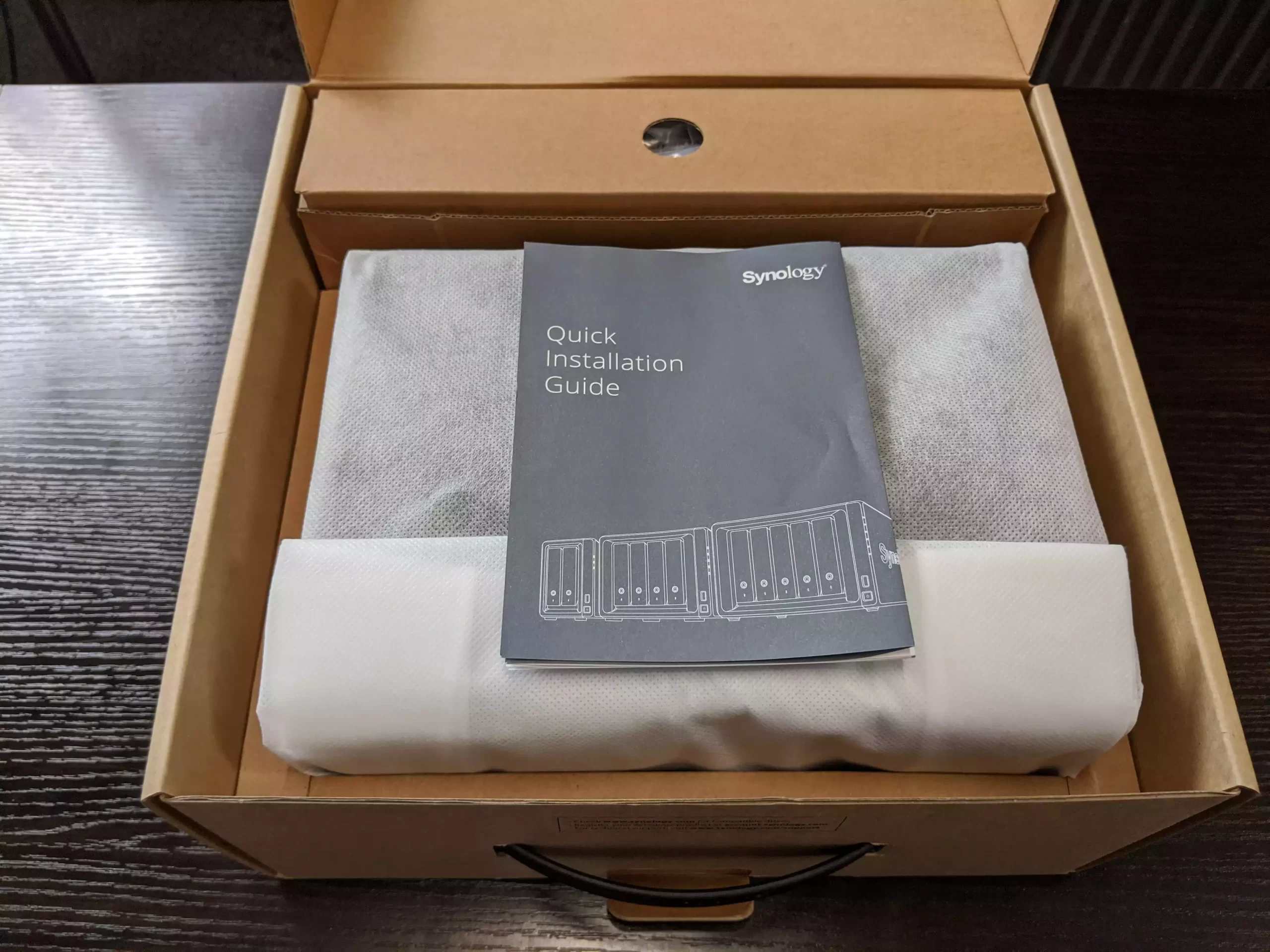
The DS723+ arrives with the accessories you would expect. The NAS unit itself, an external 65W PSU, Screws for 2.5″ media (3.5″ media installation is toolless), RJ45 Cat 5e ethernet cable, keys for the storage bays, first-time setup document and information on your warranty. All fairly standard stuff, though I am always surprised by the fact that Synology never include heatsinks for the M.2 NVMe SSD bays, given the high priority of the brand towards caching on these storage bays – something that can get those M.2 SSDs pretty hot. This is especially true in the case of this system being one of only two in the Synology hardware lineup to support M.2 NVMe SSD bays for caching AND storage Pools! This might well be the reason for the brand’s throttling of these bays in a few ways, but more on that later.
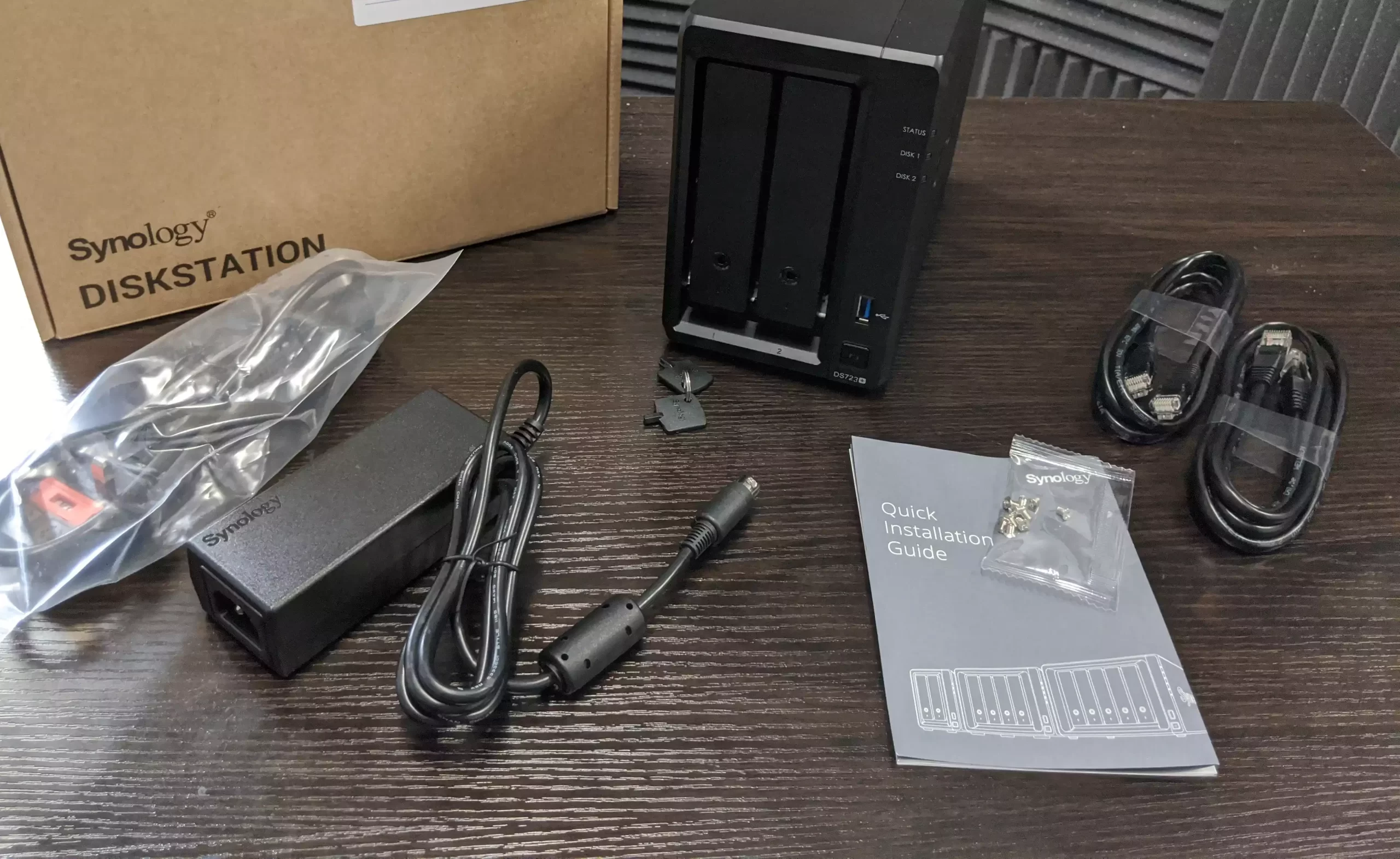
The external PSU is Synology branded, always a nice touch, and although there is a contingent of users that prefer an internal PSU (less fuss, tidier) I will always prefer an external power supplier, as it is hugely easier to replace, reduces the size of the NAS chassis itself and keeps those internal temps a little lower too. Luckily this NAS is such a low-impact model in terms of power use that a modest external power brick is completely possible.
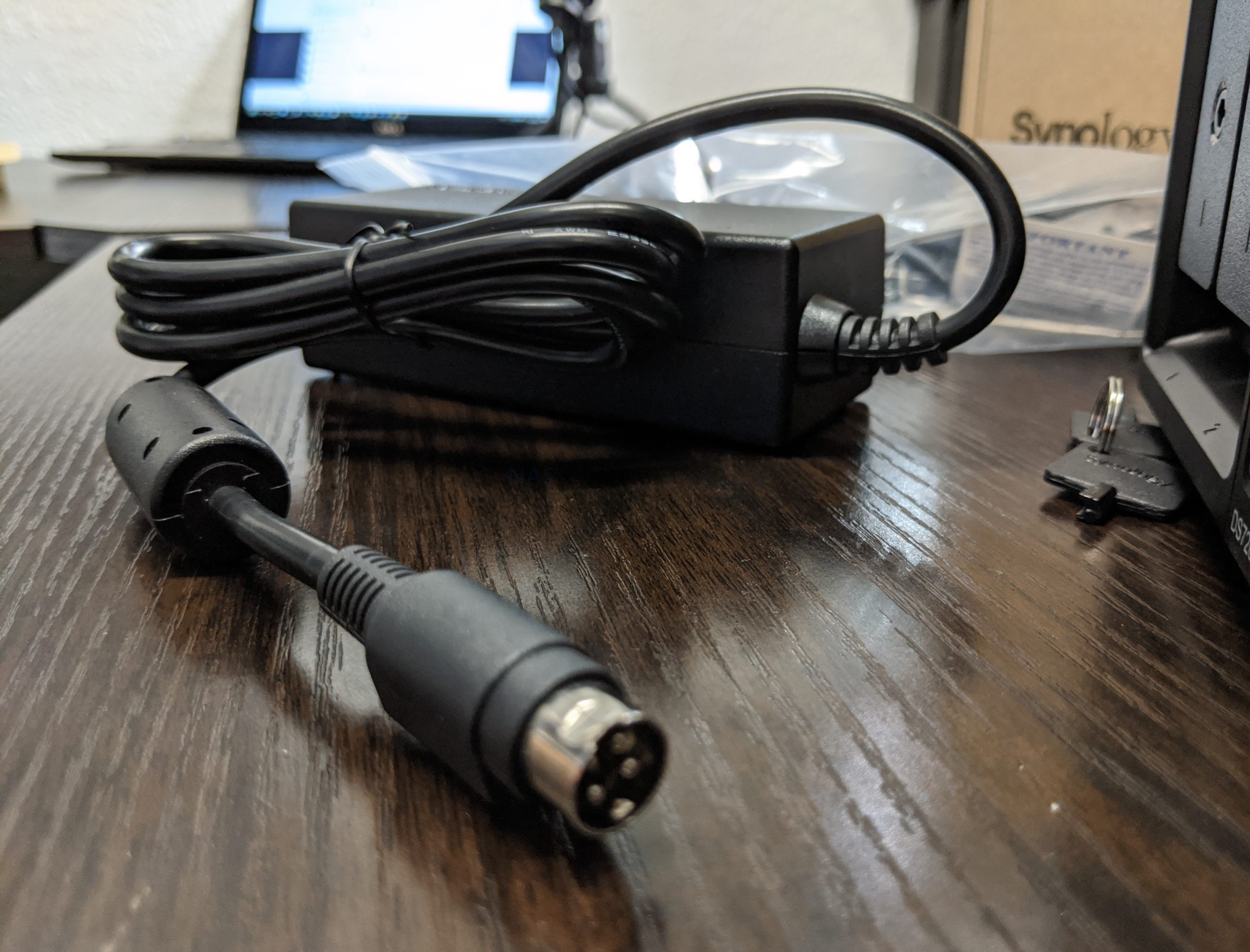
The retail kit for the Synology DS723+ NAS is all fairly standard stuff in contents, but still a very branded package and completely what we would have expected from this very brand-aware company! Let’s discuss the design of the DS723+.

Synology DS723+ NAS Review – Chassis Design & Features
The chassis design of the DS723+ NAS is largely the same as the DS720+ and DS718+ that came before it. This is a particularly well-designed device, both in terms of aesthetic design AND it’s efficient system operation 24×7, with tonnes of ventilation throughout and very structured component distribution. Also, the chassis is a largely plastic external casing in matt black, that contains a much smaller structure on aluminium internally. The result is a NAS that is pretty low noise when in operation (unless you use HDDs larger than around 10TB and/or enterprise-grade 7200RPM disks), something that alot of users who plan on taking advantage of the potential increased external bandwidth that DS723+ for photo/video editing will hugely appreciate. That said, one consistent vibe you get in the design of the DS723+ is that direct/physical interaction with the device is kept to a minimum, preferring almost entirely network/internet-based interactivity. Not a huge surprise for a ‘NAS’ of course, but there are a handful of physical attributes that are intentionally absent here. The front of the chassis lacks any kind of LCD display, instead favouring LED indicators. The bulk of the front panel is occupied by the main storage bays and these have alining of ventilation all around them to act as passive airflow.
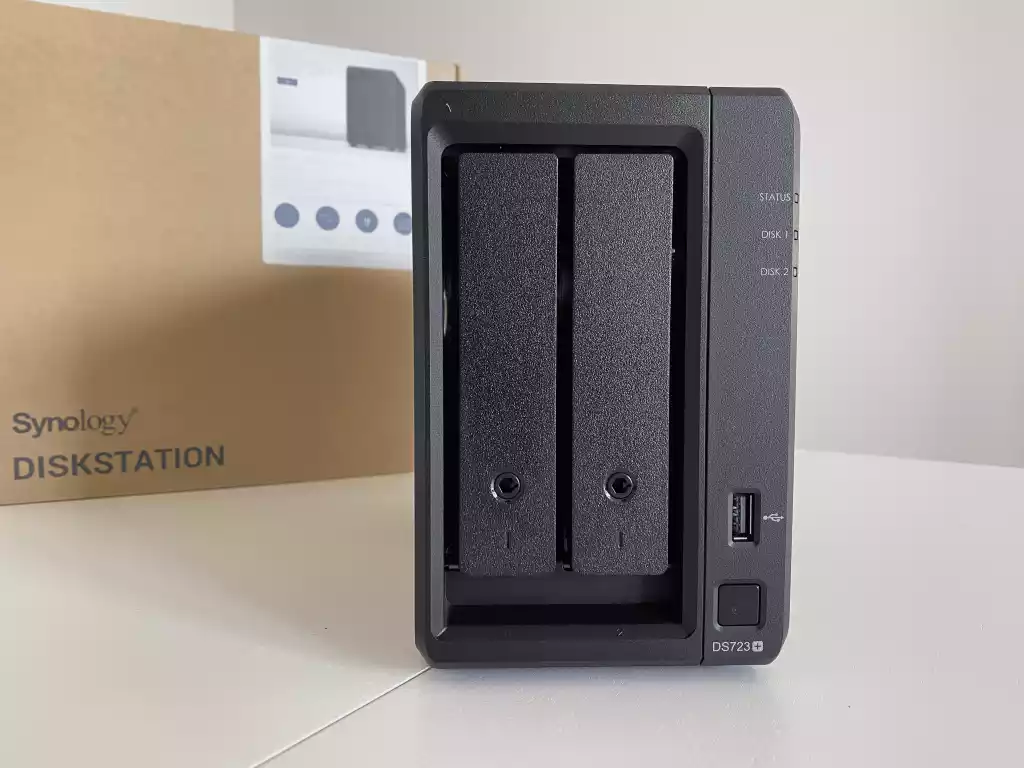
Passive airflow is definitely a big focus on the design of this chassis, with almost every side of the case featuring ventilation of one sort of around, with the Synology logo being vented. As this system will be in operation 24×7, it is heavily reliant on the rear fans to push air effectively through the system and over the assortment of internal heatsinks as effectively as possible and this chassis does that very well indeed. The Diskstation series at the 2/4 Bay level has always done a great job of melding modern design with necessary system temperature management and the DS723+ is no exception.
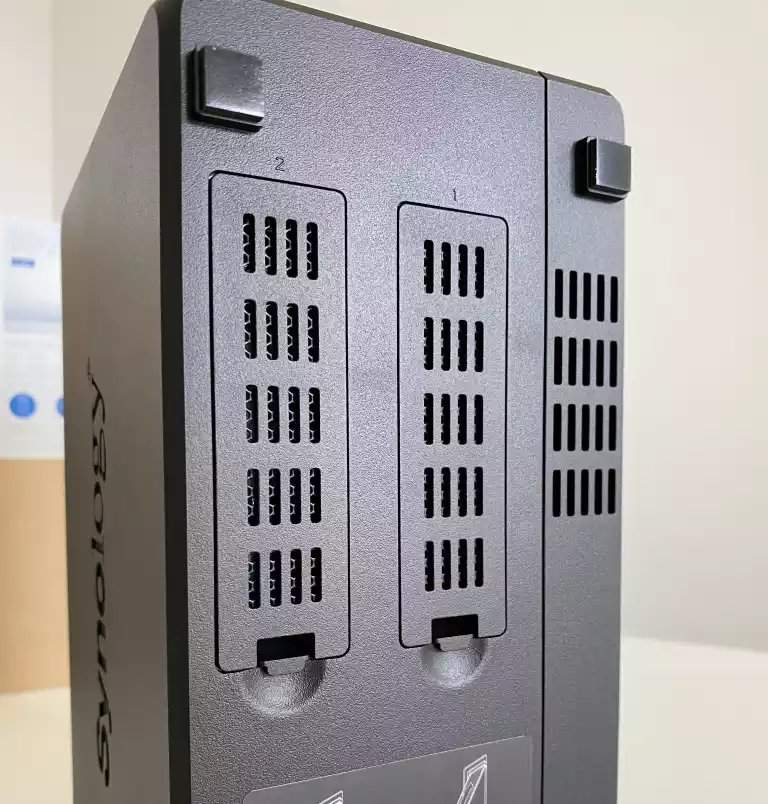
The LEDs on the front of the system use the usual three-colour system to denote drive activity and system status (network activity is absent, but the usual LEDs on the RJ45/Ethernet ports themselves are still present). These can have their brightness adjusted (or deactivated entirely) and although lack alot of the more information abilities of an LCD panel (IP addresses, system temp, alert description), they still serve ok as an initial indicator of system activity.
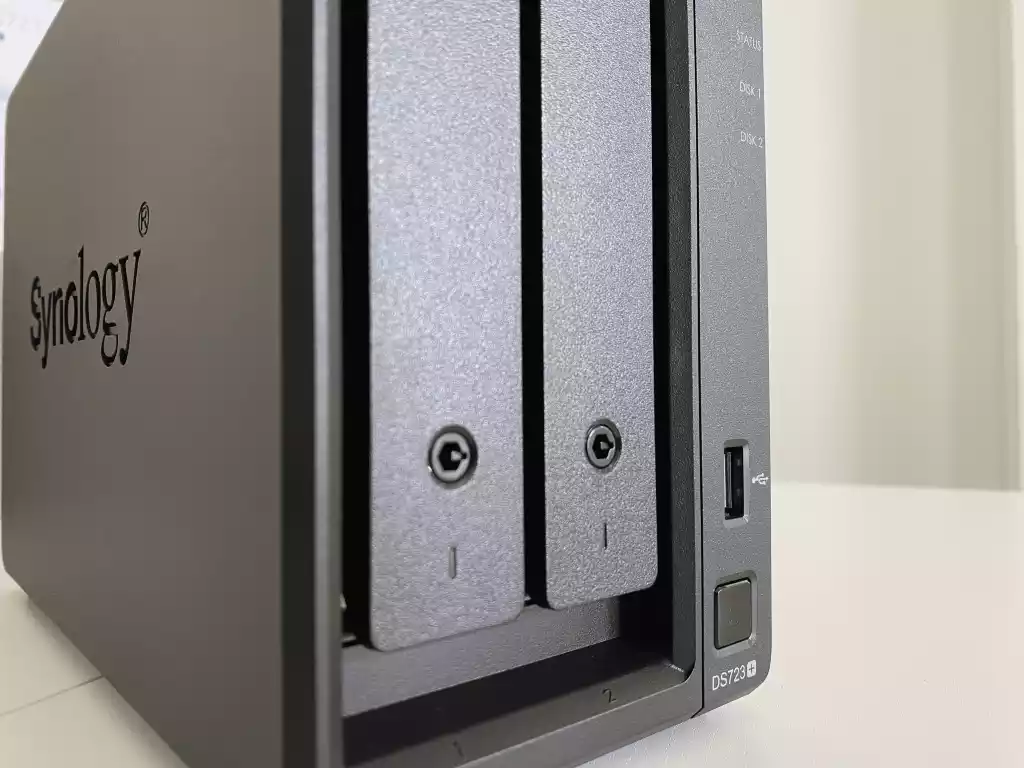
The main two storage bays of the DS723+ NAS are SATA interfaces and can be fully or partially populated with 2.5″ or 3.5″ media. The HDD/SSD compatibility of the DS723+ is still thinner than that of the DS720+, but Synology softened its stance a pinch on this subject after DSM 7.1 and the negative feedback on stricter HDD compatibility (i.e Synology media only). Although the full compatibility list is not as broad as that of the DS720+, we expect more drives to be added after launch (much as we saw with the DS1522+ and RS422+), though drives above 18TB are still absent (at the time of writing) despite 20TB and 22TB hard drives being tested on the DS723+ and working immediately. These two bays also allow you to use a large range of RAID configurations (redundant array of independent disks – a system of combining multiple drives to benefit storage scale, performance and/or data redundancy/safety-net). The usual configurations are here, RAID 0 and RAID 1 but the system also supports Synology’s Hybrid RAID (SHR) which allows you to mix different HDD/SSD capacities. It’s pretty unlikely that you will mix drive media on day 1, but if you partially populate or want to upgrade your drives gradually a few years down the line, SHR is SIGNIFICANTLY easier to expand and absorb newer/larger drives into an existing RAID. That said, the performance of SHR is a pinch lower than RAID 5 and RAID 1 conventionally, so for those hoping to take advantage of the 10GbE connectivity might do well to think about their Day 1 RAID and it’s impact down the line.
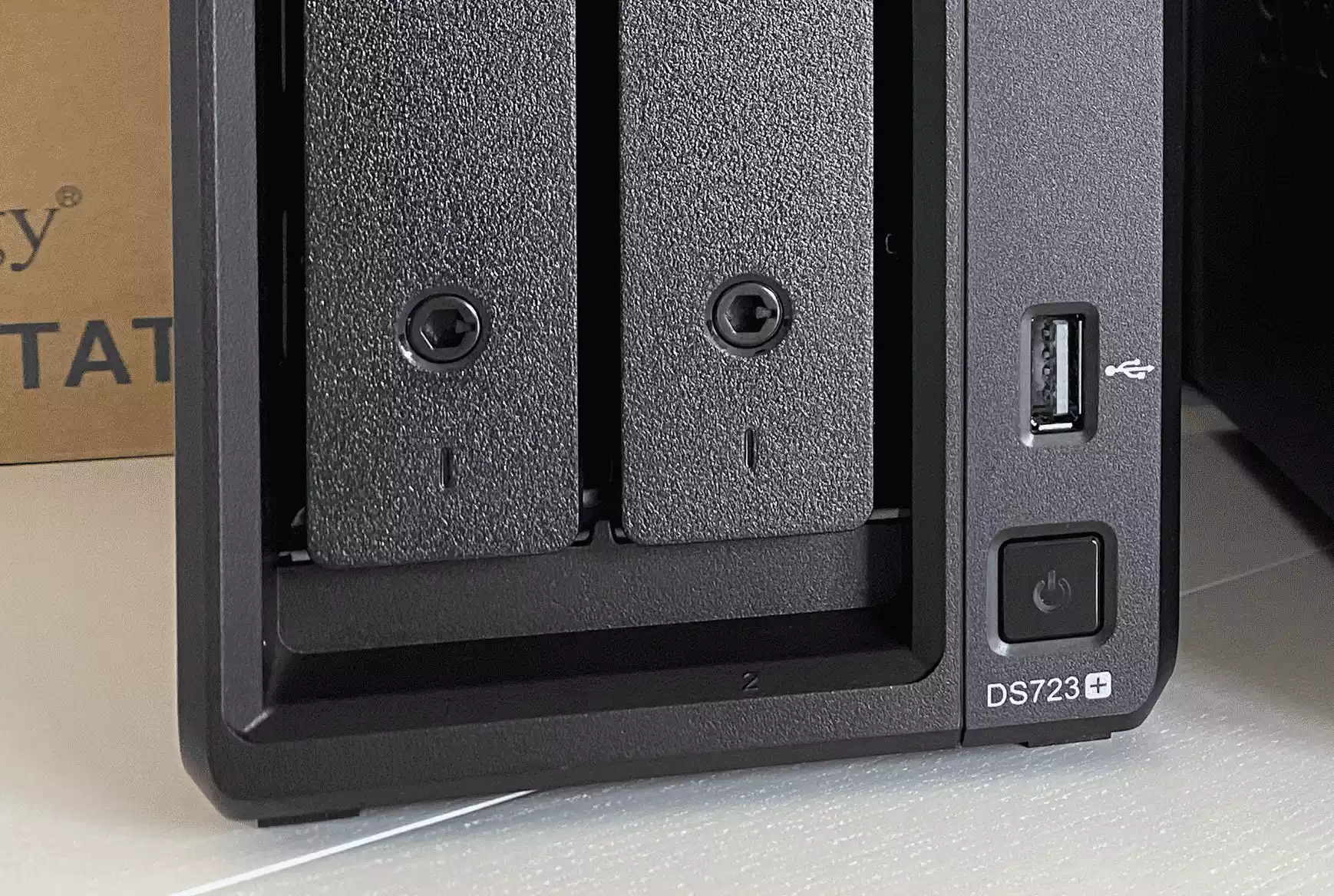
The trays themselves are plastic click-n-load tracks that feature a locking mechanism. It’s worth highlighting that this lock is by no means ‘industrial’ and removing a drive is going to be easy for particularly nefarious individuals, but this lock is more to prevent accidental removal than it is as a meaningful security barrier. The trays have screw holes for 2.5″ media to be installed with screws, but 3.5″ media is installed in seconds with the use of side clips that hold the drive in place via it’s own fixtures. The plastic tray is pretty sturdy and heat/cracking is not going to be any concern here. Also, the plastic trays will lower the ambient noise level when in operation more than metal trays would do, but (sorry to be repetitious) if you use bigger than 10TB HDDs, it is simply not possible to reduce the clicks, hums and whurs of these more industrial drives.
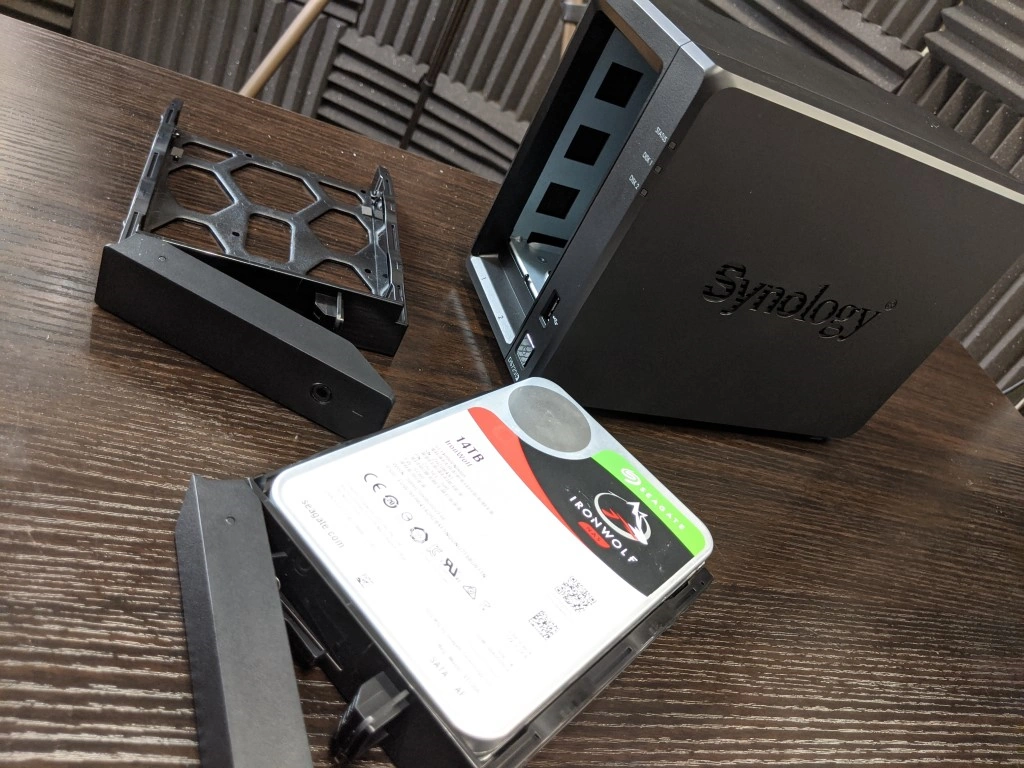
The front of the DS723+ NAS also features a USB port that can be used for connecting an external drive for backups in either direction (i. backup the drive contents to the NAS, or present files and folders to the NAS to the drive). Now, the DS723+ does not feature a front-mounted copy button (bit annoying) but DSM does include a USB copy tool that allows drives to automatically trigger a pre-set USB-to-NAS or NAS-to-USB operation when a drive is connected, which is pretty detailed in its setup (pre-set directories, age of files, exclusions, schedules, versioning, etc). The USB port is a USB 3.2 Gen 1, so 5Gb/s (500-500MB/s max bandwidth). Much like the 2.5G vs 1Gb complaints I made earlier, most other NAS brands at this hardware tier have rolled in USB 3.2 Gen 2 (10G / 1,000+ MB) ports, as well as USB-C in some cases. With the ease with which a user can add a USB tier to their 3-2-1 backup strategy (allowing them to be a little more financially creative with a network/remote/cloud backup tier as well), the slightly old skool USB port here are a little underwhelming. With significantly more affordable RAID-enabled USB solutions in the market and/or M.2 NVMe external USB drives arriving affordable to comfortably provide faster external storage for backups, this seems like a bit of a misstep by Synology to ignore. Also, DSM 7 and DSM 7.1 (with DSM 7.2 coming soon enough) have reduced the range of use of the USB port of Synology NAS systems (removing many network adapters, DTV tuners, wireless dongles, office accessories such as printers, scanners and optical drives), and limiting them largely to storage, UPS’ and assigning them to VMs. I am sure Synology has done the market research and observed reduced utilization of USB on their systems to dictate this decision, but it seems to be another move by the brand to prioritize network/remote access only with their systems.
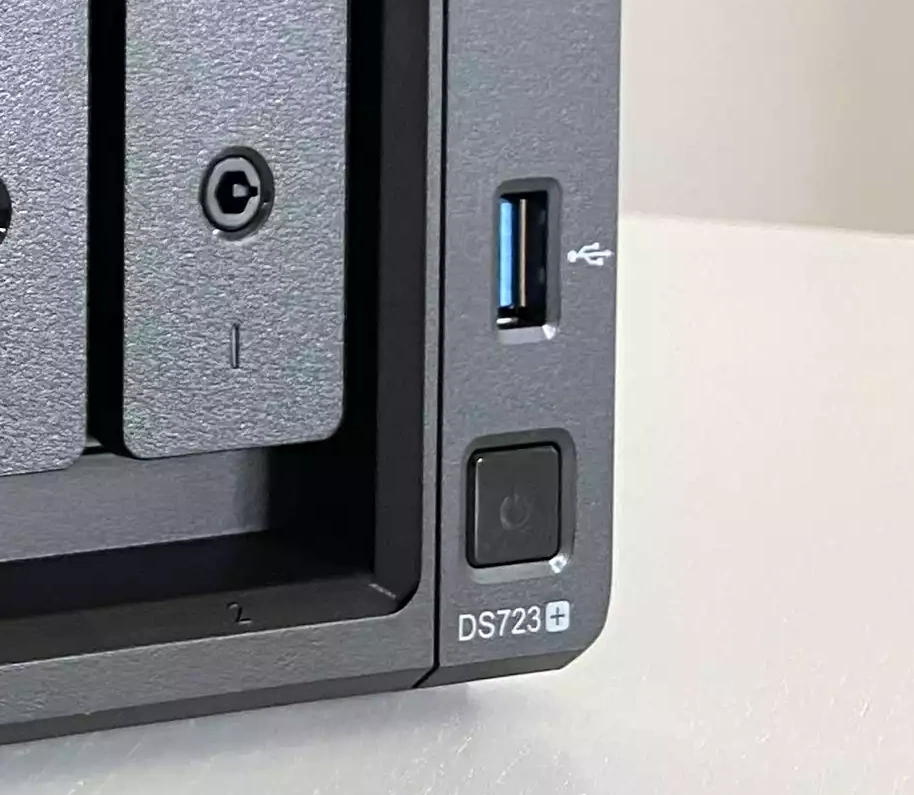
The base of the system is where you will find those two M.2 NVMe SSD slots (again, tonnes of passive ventilation) that support SSD caching in conjunction with the larger HDD array, or use as an independent storage pool. At the time of writing, you cannot initialize the DS723+ and DSM to run directly from these faster drives, though you CAN choose to install individual applications on the NVMe SSD Storage pool after initialization. You can even go a little off-piste and use one bay for Read caching and the other for a storage pool if you choose – quite nice for a 2-Bay SATA NAS to technically have 4 usable storage bays total. Space is a little tight, but there is certainly room for a couple of M.2 $8-10 heatsinks (I successfully tested the Eluteng Dual Design M.2 Heatsinks found HERE on Amazon) and definitely recommend heatsinks for drives in these bays, regardless of their use for caching and/or pools.
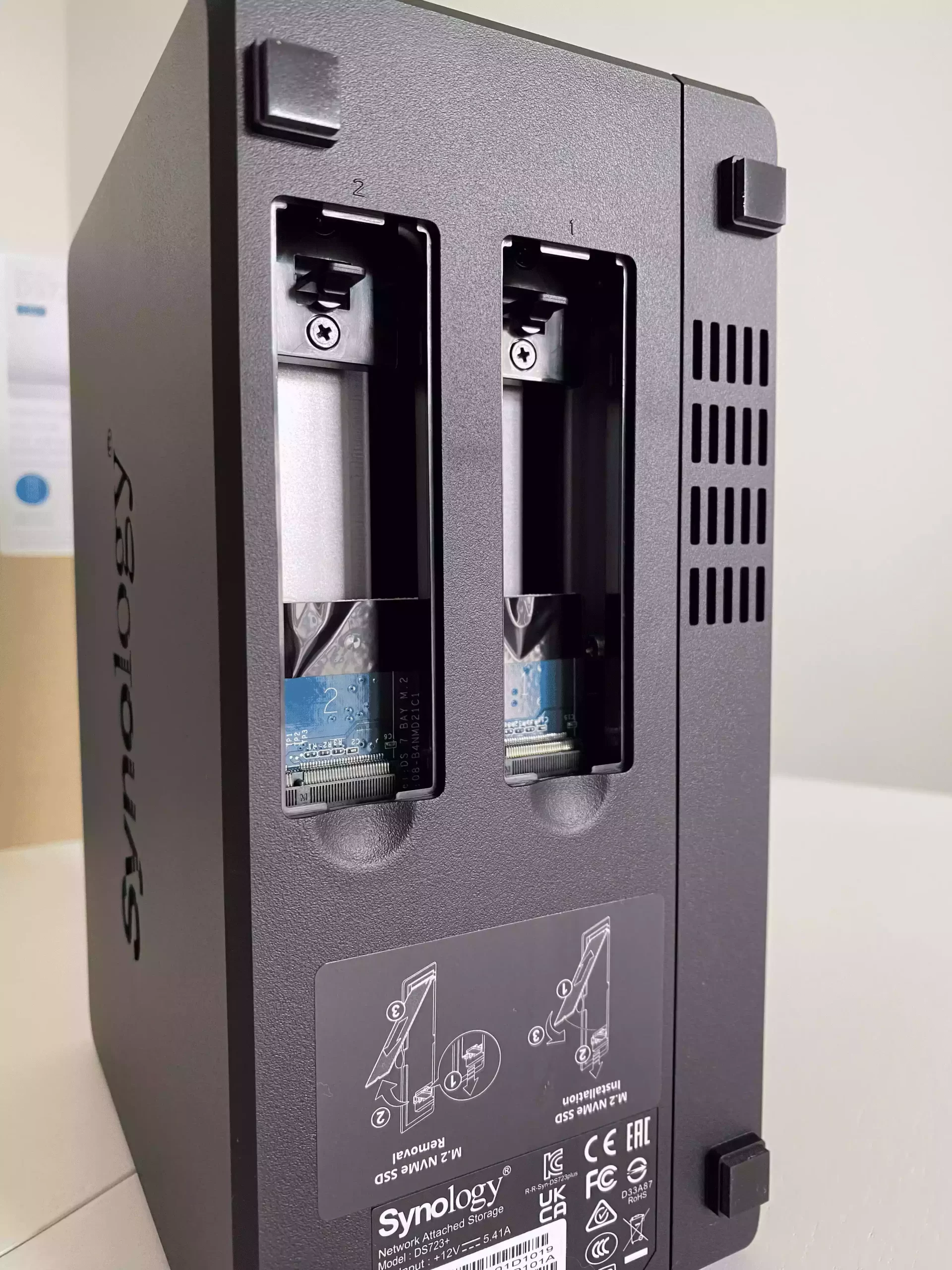
Performance on these bays will comfortably saturate an external 10GbE connection (see gif below using two M.2 NVMes below tested with AJA externally over 10GbE). This is going to be useful for those that were concerned that 2x SATA HDDs or SSDs would struggle to saturate the 1,000MB/s bandwidth offered by the 10G upgrade. However, the full bandwidth afforded by the use of these bays in a storage pool is a little less clear than many would like.
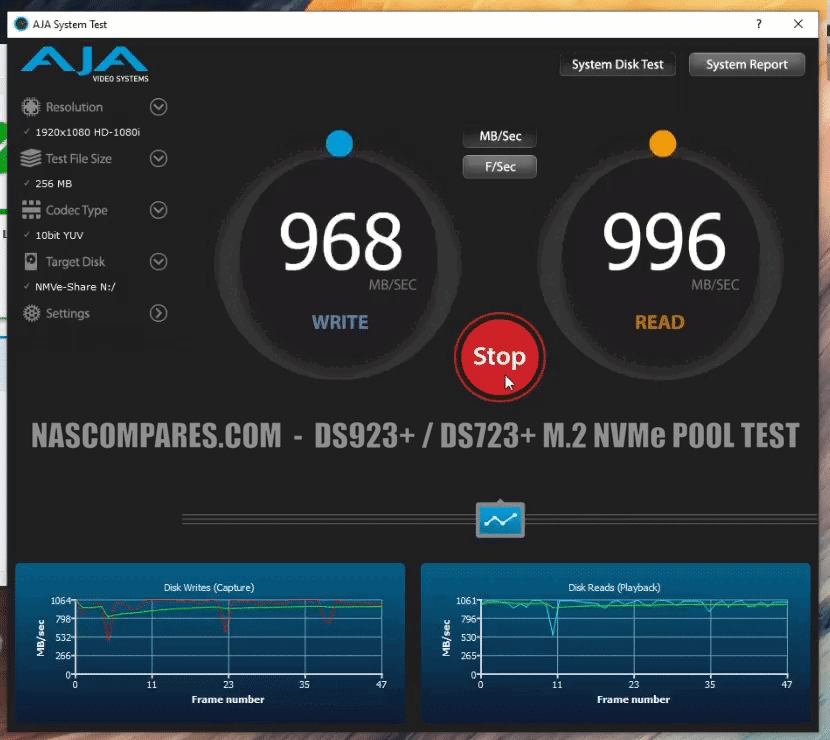
First and foremost, although these are physically PCIe Gen 3×4 Bays (checked using Putty over SSH), they have been throttled to PCIe Gen 3×1. Now, there are several reasons for this move (appearing online from 1st/3rd party sources, as well as in communication with the brand previously) with the most recurring reason being to do with increased heat from these bays needing to be avoided. Now, though this may have merit and Synology will have little reason to do this otherwise, other NAS brands offering m.2 NVMe SSD Storage pools on their systems have not included this downgrade in PCIe speed for similar reasoning (though many use processors that lack the PCI Lane coverage afforded to the DS723+ and the Ryzen, meaning fixed 3×2 or 3×1 speeds for reasons of architecture, not heat). Its a slightly odd move and one that is also further baffling when it was confirmed that the support of M.2 NVMe SSD pools on previous Synology Diskstation releases with support of these 2280 slots (DS920+, DS1621xs+, DS1821+ etc just to name a few) is not coming any time soon. It is still better to have support of M.2 NVMe SSD pools rather than not, but this has been a slightly odd way of approaching the feature and hopefully one that will see revision and improvement in further software/hardware updates in 2023/2024.
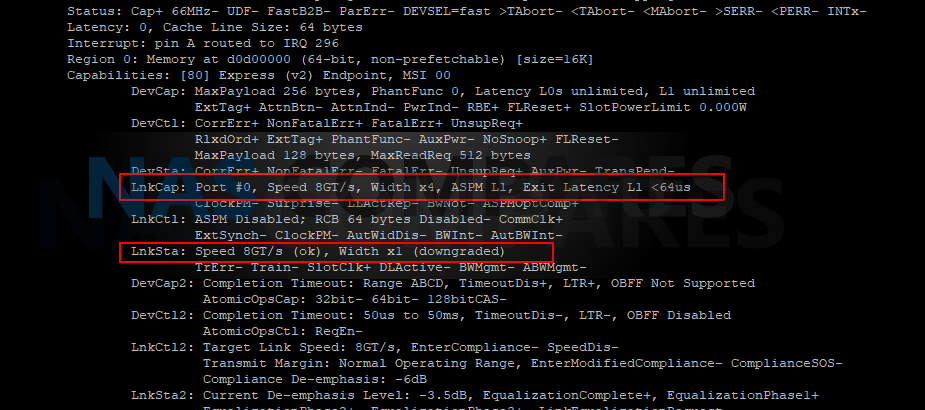
I have always been a big fan of the Synology Diskstation chassis for it’s minimalistic, yet attractive and efficient design. The absence of a USB copy button still irks me a little and the largely plastic design is not going to be to everyone’s taste, but you cannot fault the amount of R&D that has gone into the construction here. Let’s discuss the ports and connectivity of the DS723+ NAS.

Synology DS723+ NAS Review – Ports and Connections
The ports and connections that the DS723+ NAS arrives with are something of a mixed bag and compared with the 2020 released DS720+ only real include on different (but it IS a BIG difference). The system has a single active 92mm cooling fan that will automatically adjust its RPM as the system’s ambient temperature requires. You can adjust it manually if you are especially noise-sensitive, but I would really recommend it (a low system temp = better system efficiency). The fan is not immediately removable (built into the back panel of the system), so cleaning and maintenance are a little fiddly and involve removal of the bulk of the chassis, but thanks to the large amount of ventilation afforded to the system, this is not really an issue long-term.
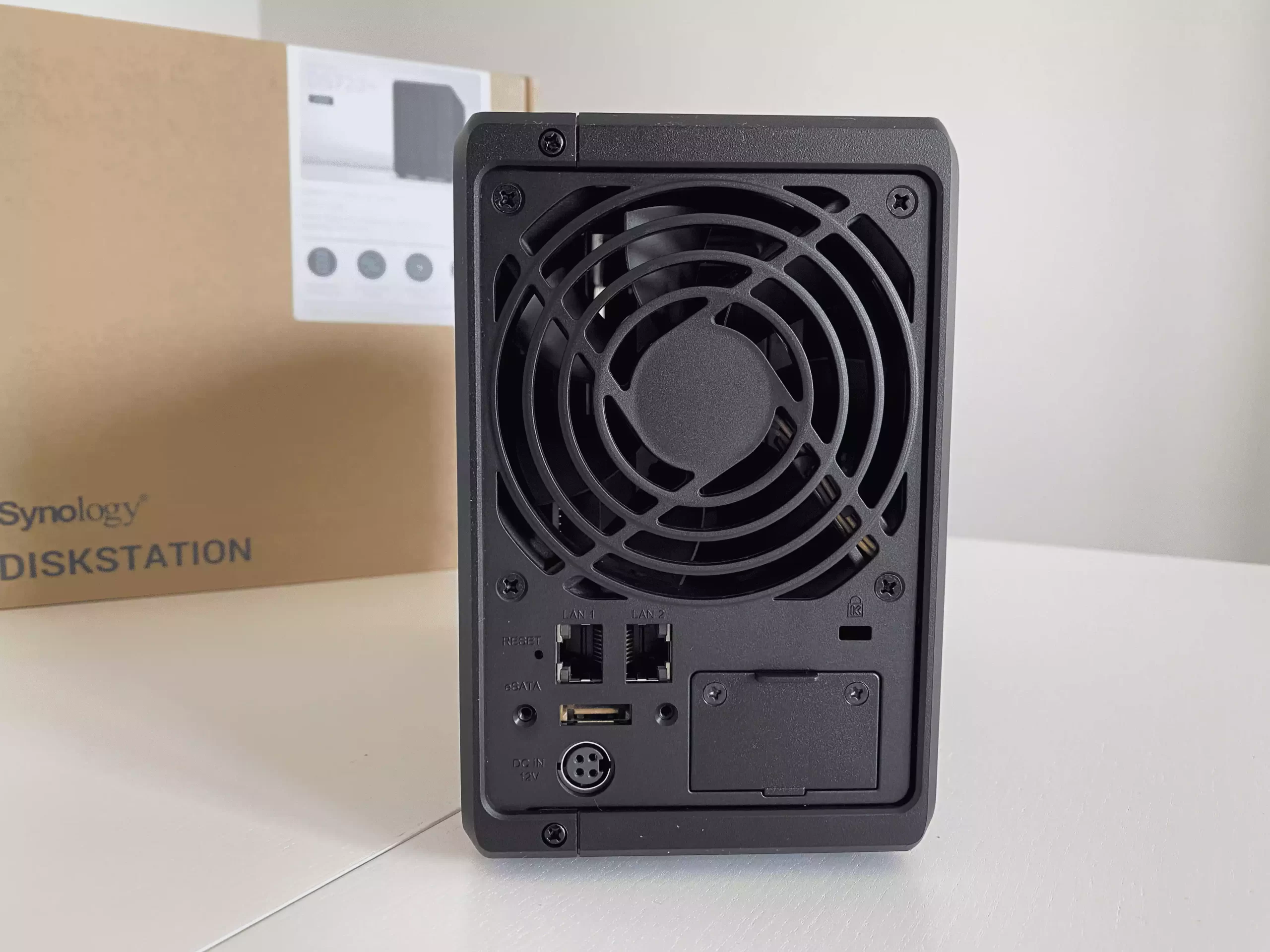
Let’s get the elephant in the room out of the way early doors! Those ethernet ports. The default model of the DS723+ NAS arrives with two-gigabit ethernet ports (the same as the DS720+, DS718+ and DS716+ before it), despite almost other commercial NAS brand producing solutions at this consumer-tier/scale arriving with at least 2.5GbE. Now, the adoption of greater than gigabit connectivity in client hardware (laptops, PCs, routers, switches, docking stations, etc) is by no means as ubiquitous as 1GbE (which has been around for decades at this point), BUT it is growing. ISPs are providing fiber internet connections globally that exceed gigabit speeds, along with 2.5GbE and WiFi 6 routers. We are seeing more prosumer switches, routers and PCs with default 2.5Gb network ports (at the same/similar cost as 1GbE), $20 USB-to-2.5G adapters and even the affordability of 10GbE on some client devices has allowed users to gradually scale up their hardware environment. The fact the DS723+ arrives at the tail end of 2023 and does not feature greater than 1GbE ports by default is quite damning. Even if you have no plans for 2.5G right now in your setup and think it something of a fad (favouring 10GbE), in terms of future-proofing and the general standard or networking hardware right now, gigabit ethernet is a surprising weakness here.

HOWEVER, we do need to acknowledge the bit change that the DS723+ brings over it’s 2.5yr older predecessor – the ability to upgrade your network connectivity to 10GbE. The DS723+ is now the 4th Synology NAS to arrive (after the DS923+, DS1522+ and RS422+) with support of the Synology E10G22-T1-mini, a proprietary network upgrade module that is one of the easiest and quickest upgrades that I have ever seen to 10G to install! This module fits neatly (by design of course) into the PCIe Gen 3 x2 network upgrade slot, though powering down the device is necessary during installation. At first, I was a little sceptical about Synology providing a 10GbE upgrade to the DS723+ via a custom-made and largely proprietary designed upgrade module (thereby limiting you to ONLY the Synology PCIe upgrade, but not any other traditional PCIe Card 10G upgrades), but over time I have come round a little on this one.
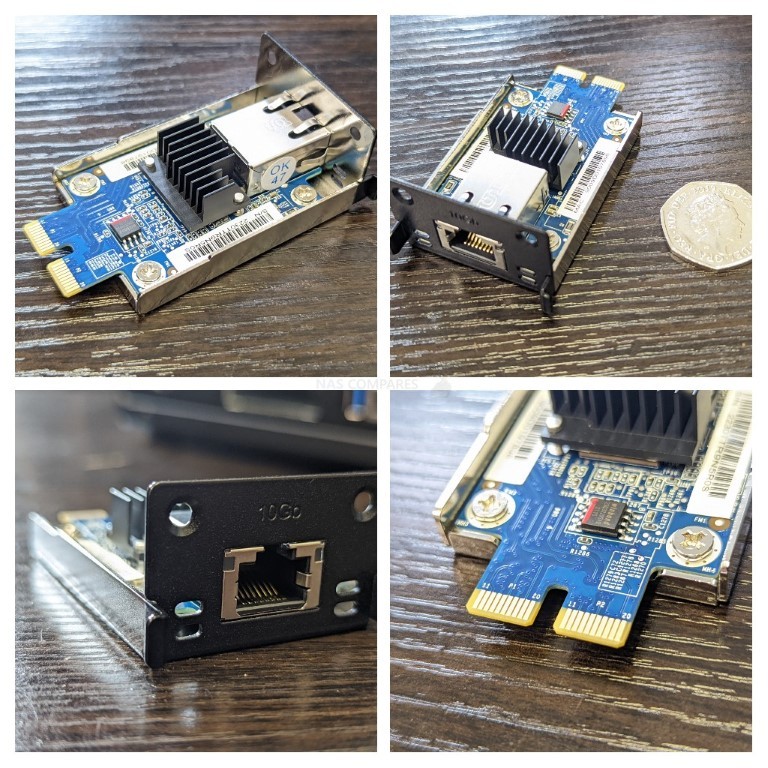
I like how easy this is to install (zero case deconstruction) and it is a very well-designed component (not just a rebadged card with a logo). The 10G upgrade is only available in copper (RJ45/10GBASE-T) currently, but I would not be surprised if Synology roll out an SFP/SFP+ version down the line. As much as I would like to see this port and it’s utility get expanded (2.5G/5G, Dual port?), realistically this is still a PCIe 3×2 slot (so maximum 2,000MB/s to play with and that’s without network/hardware friction) and the physical space here is pretty small.
PERFORMANCE TESTING IN PROGRESS! IMAGES VERY SOON
The next question many will have about the DS723+ and this optional 10GbE upgrade is, can you even saturate a 10G (1,00MB/s+) connection with 2 bays of SATA storage? It’s a good point, as generally, domestic-class NAS HDDs will give you about 180-220MB/s max, with enterprise-class (or Pro) drives giving you 250-275MB/s. RAID configuration will add to this by increasing performance per drive bay. On Synology’s own pages, they rate the device to hit 471MB/s Sequential Read and 225MB/s Write – arguably quite slow numbers in the grand scheme of things. Of course, using SATA SSDs and/or M.2 NVMes in flash based storage pools will tell a very different story (with the latter EASILY maxing a 1,000MB/s connection, as seen in the previous gif above). That said, this port bing proprietary and unique to this product family/generation mean that there are a number of other Synology NAS PCIe upgrades that are unsupported. Although the NAS chassis size is an obvious and unavoidable factor (as is the saturation on offer), but hopefully that SFP+ support and perhaps compact dual port options might come on day…
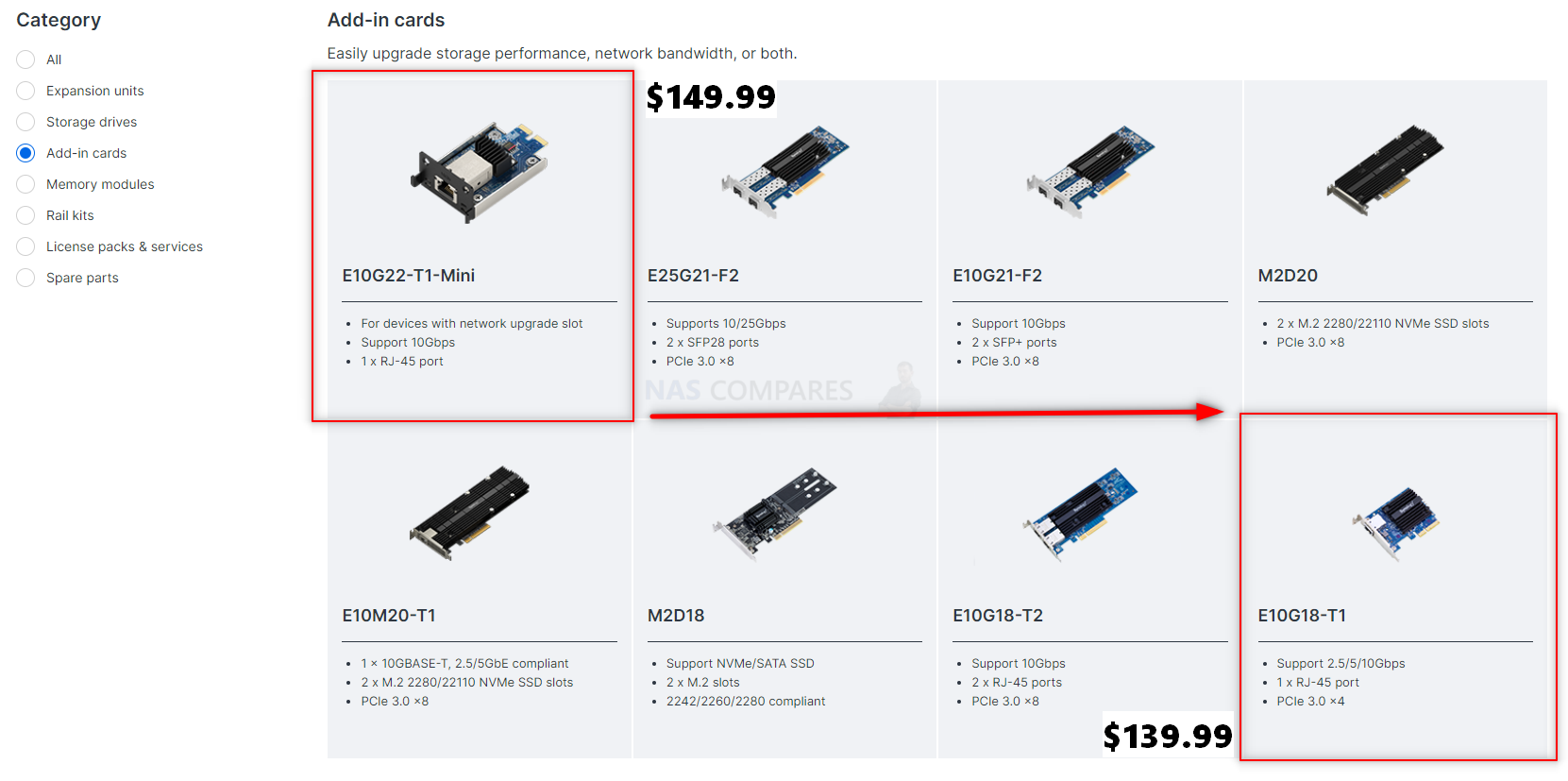
Another thing I wanted to touch on was USB and… well… the lack of a rear port! I was rather surprised by this as, although the support of USB peripherals has dropped in DSM 7/7.1 (discussed earlier), the lack of a 2nd USB port on the DS723+ NAS is an odd move. Moving aside from additional storage add ons for backups and simply storage carry-over, smart UPS’ that still use USB connectivity and/or assigning a USB device to a VM in Synology Virtual Machine Manager (VMM) is going to now become a bit of a swap fest! Lastly, there is the expansion port that allows you to attach the official 5-Bay DX517 expansion device. This £350-400 5x SATA Bay JBOD enclosure is connected via a screw-in eSATA connection and allows you to either expand an existing RAID to increase the drive quantity and capacity overall (though not recommended to spread RAIDs over NAS+Expansion). Alternatively, you can use the expansion as a means to create an additional separate RAID configuration (which can also be gradually populated) that is treated exactly the same as the internal storage of the DS723+. The fact this expansion is JBOD only means that the RAID is managed by the main DS723+ device (which given the expansion cost, is a little annoying), but having this expandability is very useful. You cannot use third-party eSATA JBOD enclosures (unsurprisingly) and you can not get smaller/larger expansion chassis that are compatible with the DS723+, but the support of an expansion does mean that your storage options years down the line have this official option.
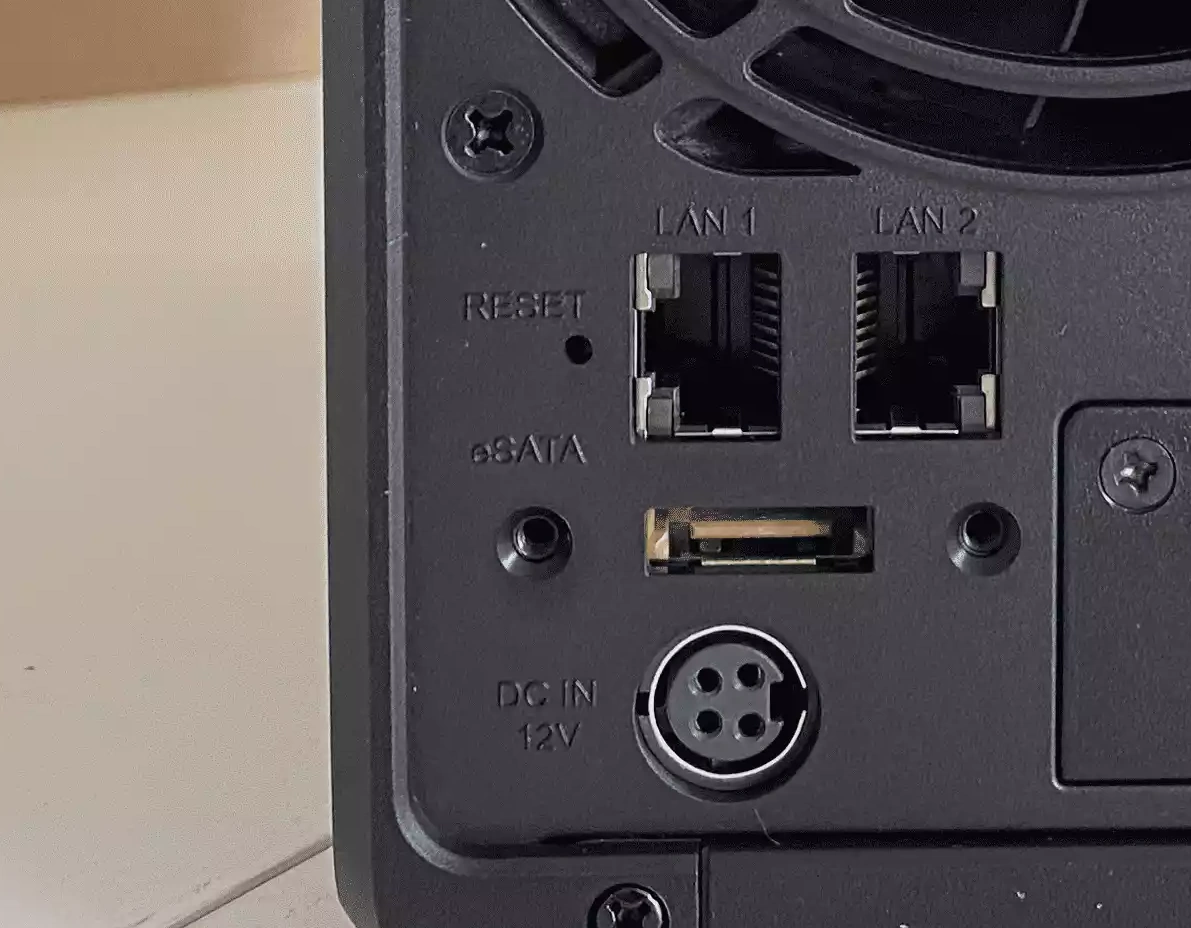
Overall the ports and connectivity of the DS723+ are technically no differences in the base model than the 2.5yrs older DS720+, it is only the option to add improved network connectivity towards 10GbE (and paying £129-139 extra for that) that makes this any way improved upon as a refresh of the older device. This upgrade is certainly welcomed, but there is still the hanging question of why they could not just roll this into the DS723+ as a default port on day 1 and just increase the price £100 – as I think there is a good % of NAS users who would have preferred this (especially with 10GbE largely supporting auto-negotiation with 5G, 2.5G and 1G, therefore allowing backwards compatibility). The expandability remains exactly the same too, which is useful but with only supporting the single expansion type and the lack of rear USB port, things are a little ‘blah’. Let’s take a closer look at the internal hardware and discuss the other big changes that the DS723+ brings over its predecessor.
Synology DS723+ NAS Review – Internal Hardware
This is likely to be one of the biggest areas of contention for many users who have been waiting for the release of the DS723+, as the hardware choices that Synology has made for this system are quite a change of architecture that many expected. The internal framework of the DS723+ is an aluminium storage cage for the main SATA bays, with its own multi-port backboard. The same goes for the M.2 NVMe SSD bays, with both of these boards connecting to the controller board that has CPU and Memory storage. As mentioned earlier, the DS723+ does not take advantage of any active cooling systems (beyond the rear fans) and is heavily reliant on heatsinks internally to dissipate the heat from key components like the CPU and disperse that heat into the air. The CPU inside the DS723+ is the AMD Embedded Ryzen R1600 processor, an x86 64bit Dual core, four-thread processor with an impressive base level clock speed of 2.6Ghz that can be scaled up to 3.1Ghz when needed. Now, the DS7xx+ series has always arrived with a Quad Core Intel Celeron (or Pentium) processor in the past and when it was revealed that the DS723+ was arriving with a dual-core embedded ryzen, many users were a little unhappy. This was largely down to two factors. The first was that the R1600 is a dual-core, not the four-core that everyone expected. Now the R1600’s four-thread architecture does allow the CPU to spread out quite alot across tasks and services (as well as virtual CPUs in VM deployment), as well as having a higher power in both base and burst mode available, which means it isn’t a bad CPU! But the bigger area of contention from some buyers is that the R1600 lacks integrated graphics. This means that for some tasks and services that are more graphical in nature, the result will be a higher typical CPU Uages % than a processor that has a more specialized graphics management component onboard.
How the Synology DS720+ Intel Celeron J4125 and DS723+ AMD Emb.Ryzen R1600 Compare:
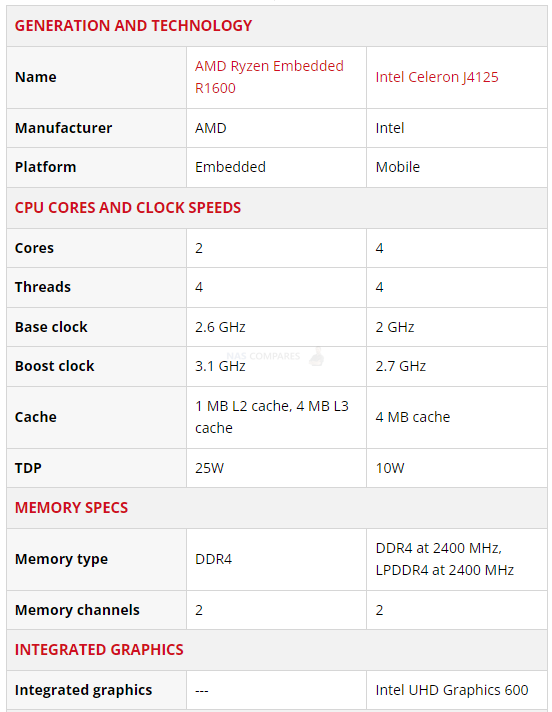
The traditional data handling of the R1600 is very good, as seen in our DS1522+ testing earlier in 2022. As far as DSM (the Synology software) is concerned it will be able to run EVERYTHING! Additionally, the general file handling and throughput internally are going to be great too, so all good news. Then you have the advantage of the newer gen CPU in the DS723+ over the DS720+ supporting PCIe3 lanes, affording greater bandwidth to the rest of the hardware (i.e those M.2 slots being higher bandwidth and enabling that network upgrade slot), all the while with the CPU having the potential to hit 3.1Ghz of power when needed. It is genuinely a good CPU and there are lots of reasons why Synology have opted for this CPU, but it is by no means perfect and some specific user setups and their concerns do have merit.
For a start, the AMD R1600 has a higher typical usage (unsurprising for the spec and generally identified as TDP, as a maximum) compared with the avg Intel Celeron being used in other NAS systems released in 2022 (such as the Intel N5105 or J6412) and in a system that will be in operation 24×7, this is going to a question mark for those affected by erratically rising energy prices right now, The difference might only be pence on the day, but those pence add up! Then there is the dual cores. Although having the four threads IS handy and will be useful, Cores will always beat threads when it comes to capabilities. Finally, there is that lack of integrated graphics. Most users will not notice this as an issue in day-to-day use, but multimedia users and especially a large % of Plex users will notice, if they are a little more reliant on the server-side processing than on the client. For example, if your media collection contains alot of dense/complex audio media (RAW, MP4a, etc) OR alot of higher-end HEVC/H.265 Media BUT you do not have client hardware that supports these types (or allows local client conversions/transcoding), then the NAS will have to use raw horsepower to get the job done – much less efficient than embedded graphics doing the job. Again, you might not be impacted by this (your client hardware might have enough power and privileges, or you own a local HEVC-licensed device), but it IS a concern if you are running a Plex Media Server on the DS723+ and need the NAS to convert files on the fly. Earlier in 2022, I compared the DS720+ (with a Celeron) vs the DS1522+ (with this same AMD R1600) in a detailed YouTube video testing 4K Media in Plex. Here are the results:
Next, we can move on to the other big internal change that the DS723+ NAS has arrived with over the DS720+ before it, the Memory. The DS723+ arrives with 2GB of DDR4 Memory like it’s predecessor, which is half the memory of the 4-Bay DS923+, but after that it is all change! This memory is ECC (Error Correcting Code) memory that is more often found in enterprise NAS setups, due to its higher pricetag, but also its huge benefits towards avoiding bitrot and silent data inconsistency that are not going to be spotted till years down the line when accessing old data. As data passes through the memory, the memory has an additional onboard module that is designed to be constantly making a blueprint/snapshot/parity bit of the data at the start. This is then used to check the data on the exit path and if there are any inconsistencies, the data is remapped/repaired to its original form.
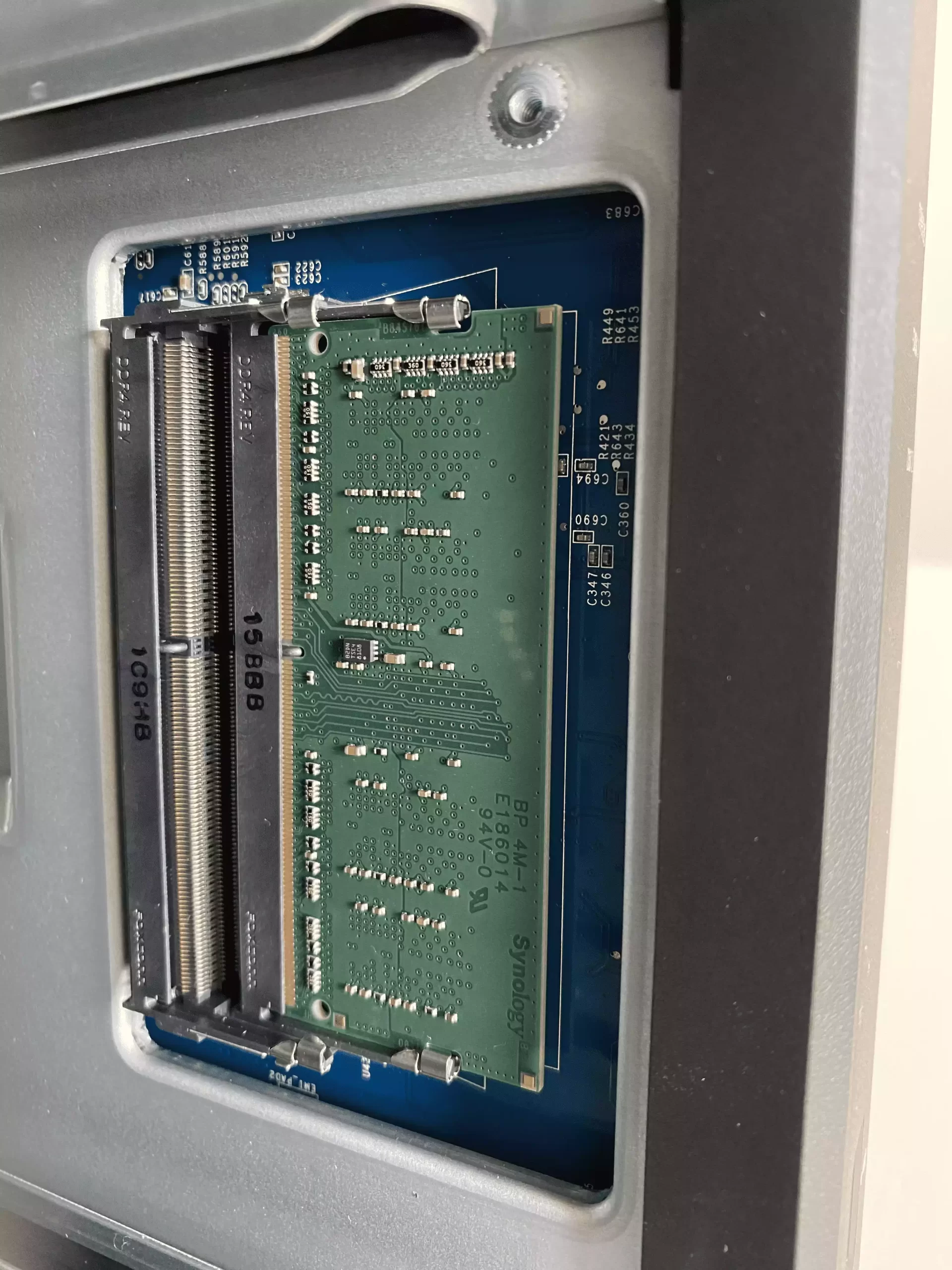
ECC Memory has appeared on lots of Synology NAS’ over the years (with pretty much ALL devices higher than ‘mid-high business having it as standard now), so it is great to see it here on this 2-bay diskstation model. In other good news, whereas the DS720+ had 2GB of memory that was soldered to the main controller board and could be upgraded to 6GB with 1 free slot, the Synology DS723+ has two slots available (one prepopulated with the initial module) and can be upgraded to a massive 32GB. This again is thanks to that R1600 CPU being used. Although Synology still maintains quite a tight compatibility/whitelist on supported memory modules (stating that you can/should ONLY use their own first-party modules), I cannot fault the choice of memory and its upgradability here!
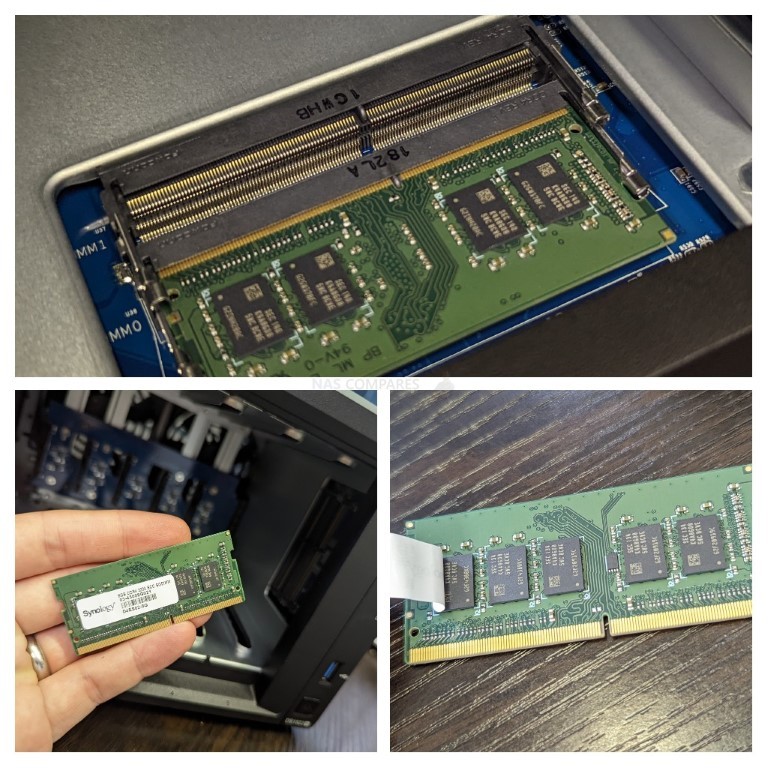
In summary, in terms of the internal hardware, I am mostly happy. The lack of an integrated graphics processor (especially when the same AMD Embedded Ryzen R1000 CPU family has a graphics-equipped model, which was passed over here for the R1600) is a real pain for alot of users, but by no means does it mean this NAS is a write-off! That CPU has alot of capabilities, has opened up the hardware on the system to greater bandwidths, is capable of great internal+external performance and outside of conversion-based activities in multimedia, and still plays 4K and 1080p media very well. There are a few other details regarding AMD Emb.Ryzen vs Intel Celeron that you can learn more bout by reading this article HERE, but let’s move on to the Software side of the Synology DS723+ NAS and DSM 7.

Synology DS723+ NAS Review – Software and Services
At Launch, the DS723+ NAS arrives with the latest version of Synology software, DSM 7.1. However, this does not stop evolving as soon as you get your Synology NAS. DSM has been in continues to be the dominant force in the world of NAS software, providing a massive arrangement of services, applications (first and third-party supported) and a huge number of client applications for desktop, mobile, Windows, macOS and Linux (as well as a bunch of other more home-based tools). These allow management and access to the data on the DS723+ in very tailored ways, as well as the web browser-based access that has the appearance, intuitive design and responsiveness of a local operating system. The DSM interface can be accessed by hundreds of users at the same time (with each user having tailored access, rights and privileges). DSM is available with ALL Synology NAS and the depth and abilities of DSM on any NAS are dependent on the hardware architecture of the NAS itself. In the case of the Synology DS723+, it supports EVERYTHING that is offered by Synology’s platform. DSM is currently in version 7.1, but it looks like we will be seeing beta/full release of DSM 7.2 at the start of 2023, which will be adding WORM (write Once Read Many) support, Volume scale encryption and numerous improvements to individual applications. If you want to learn about the DSM 7 and the software and services that are included with the DS723+ NAS, watch my FULL review below (alternatively, you can read the DSM 7 Full Review HERE):
As mentioned, the DS723+ supports pretty much the entirety of the DSM 7.1 applications and services (DSM 7 and DSM 6.2 are still in circulation and still receive regular service and security updates, though the DS723+ will arrive with DSM 7.1 by default and cannot be rolled back). If you are an existing user of SaaS and PaaS (Software as a service and Platform as a service) from the likes of Google Workspace and Office 365, knowing that you can synchronize these systems or choose to export away from them onto the Synology services is going to be very appealing. Then there is the increasing development of their 1st party cloud platform, Synology C2, which is slowly integrating into all the applications that are available on your bare metal NAS (allowing you to add a cloud layer of backup, synchronization and access to your data storage setup). This is a subscription platform, which can only be used with your Synology NAS system (as well as connected with some 3rd party SaaS services, but for those that are moving away from Google/Microsoft/AWS for security reasons, but still want a Cloud+Metal storage network in place, C2 covers pretty much everything. Indeed, although below I have highlighted a number of the key/best applications that are included in your DS723+ Service with DSM, most of them can be immediately integrated with Synology C2 (with even more being added in 2023 with DSM 7.2). Key business and consumer applications that are included with your NAS are:
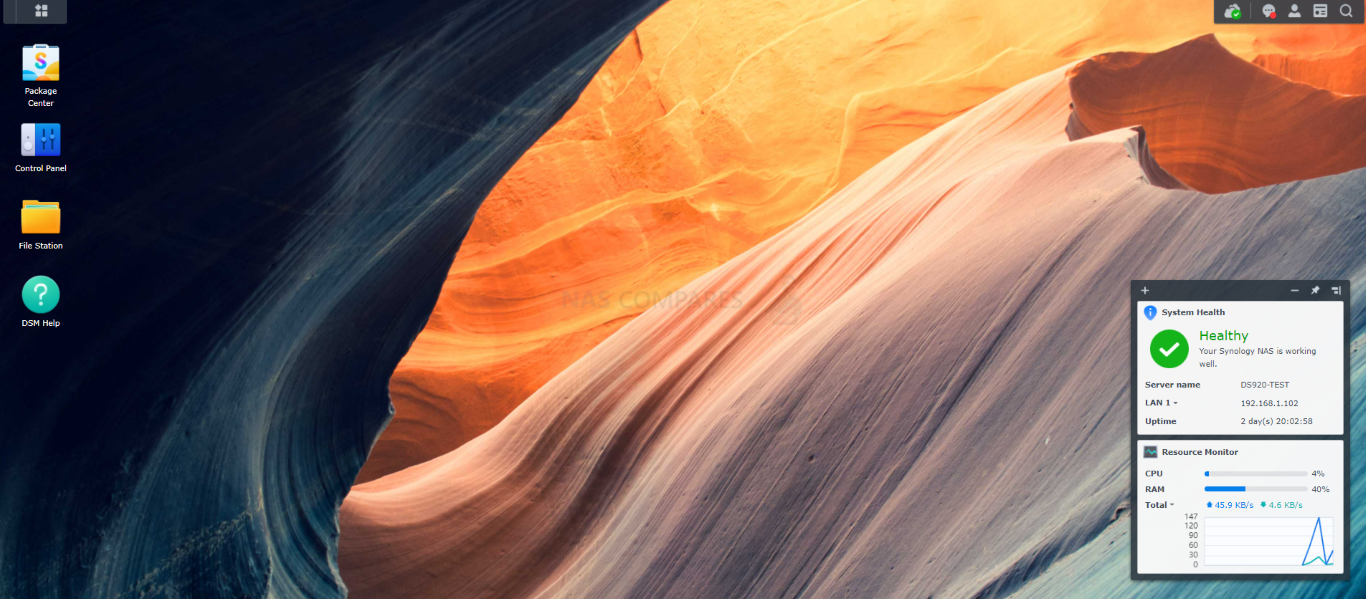
Synology Office – Create documents, spreadsheets, and slides in a multi-user environment. Real-time synchronization and saving make collaboration a breeze.
Synology Chat – Aimed at businesses, Synology Chat is an IM service that transforms the way users collaborate and communicate.
Synology Drive – Host your own private cloud behind the safety of your NAS with 100% data ownership and no subscription fees. Drive has become one of the premier applications of DSM and allows uses to create intelligent shared team folders that support versioning, file streaming+pinning, encryption, Windows AD support (soon) and native file system support with Windows and macOS.
Synology Photos – Manage your photos and videos with deep-learning algorithms that automatically group photos with similar faces, subjects, and places. Designed after the merger of Synology Photo Station and Moments, it also includes tailored folder, sharing and categorization features to help photographers manage their photos and share them with clients for feedback or business development.
Synology Calendar – Stay on track, share calendars, and schedule meetings, while ensuring sensitive information remains safely stored on company premises.
Synology Active Backup for Business (ABB) – Consolidate backup tasks for virtualized environments, physical servers, and personal computers, and rapidly restore files, entire machines, or VMs – license-free. This software also arrives as a specialised Microsoft Office 365 and Google Workspace platform to sync with those platforms and allow a bare metal tier to your cloud office services
Synology Hyper Backup – Backup your NAS safely and efficiently to multiple destinations with deduplication, integrity checks, compression, and versioning.
Synology Surveillance Station – Safeguard your business, home, and other valuable assets with reliable video surveillance tools. With improved AI services being accessible thanks to Synology BC500 and TC500 Cameras arriving in 2023. Additionally, you can connect this platform with Synology’s cloud platform to use ‘C2 Surveillance’ and bolster the odds of recordings being maintained in the event of accidental/malicious damage to your surveillance system.
Synology Virtual Machine Manager (VMM) – An intuitive hypervisor that supports Windows, Linux, and Virtual DSM virtual machines. Its powerful disaster recovery tools help users achieve maximum service uptime.
Synology High Availability – Synology High Availability (SHA) combines two Synology NAS servers into one active-passive high-availability cluster, alleviating service disruptions while mirroring data.
Synology Central Management System (CMS) – Synology CMS allows you to manage multiple Synology NAS servers quickly and conveniently from a single location.
Synology Video Station – Manage all your movies, TV shows, and home videos. Stream them to multiple devices or share them with friends and family.
Synology Audio Station – Manage your music collection, create personal playlists, stream them to your own devices, or share with family or friends.
Synology File Station – Manage your Synology NAS files remotely through web browsers or mobile devices. This tool allows complete file management and contains all the features and services of your own native file management platform (archiving, extracting, Copy, Cut, Paste, Sharing, native file format opening, integration with the rest of the Synology applications, property/metadata access, etc)
You cannot really fault the software and services that are included with the Synology DS723+ NAS, as you are going to get the very best experience available on the platform, thanks to the hardware and architecture of this NAS. DSM 7 is an ever-evolving platform, so if you are reading this now at the time of publishing or years later, there is always going to be something in DSM for everyone. That said, Synology in recent years has been increasing its priorities towards first-party software and services. This does make sense, as they want to promote their systems and software as a complete ecosystem for your home or business data storage needs (going on in the last few years to release even more Synology alternatives to popular software AND releasing non-NAS hardware accessories such as Routers, Network Adapters, HDDs, SSDs and now IP Cameras). This can occasionally lead to the compatibility lists of hardware or software that you wish to use in conjunction with the DS723+ NAS being a little smaller/restricted than you might like. A specific 3rd party software/service or physical accessory (HDD, Memory module, Network Upgrade) might not appear on the Synology compatibility pages, but that does not mean it will not function with the DS723+ NAS. It is more a case of Synology choosing not to test/evaluate a particular setup (in their defence, there are ALOT) and therefore until stated otherwise is therefore listed as incompatible and is therefore being used without their full, guaranteed support long term. In short, you can DEFINITELY feel that DSM 7/7.1 is a fantastic NAS platform, but it comes with a certain degree of rigidity by Synology on the DS723+ NAS. A little more relaxed than entries in the Enterprise XS or SA systems, but it is definitely still there.
NOTE – Video Review is ‘In Progress’ and will include the 10GbE and DSM 7.1 Testing, which will also be added to this review shortly afterwards. Apologies for the delay.
Synology DS723+ NAS Review – Conclusion & Verdict
There is no denying that the Synology DS723+ NAS is the most powerful, capable and upgradable 2-Bay that Synology has EVER released. Although the AMD Ryzen dual core Ryzen CPU is going to be a sticking point for those who wish a quad-core and/or integrated graphics CPU had been used (eg video conversions server side in Plex and the like) – the capabilities of the DS723+ NAS in it’s traditional performance, handling and throughput are better than they have ever been on ANY other Synology 2-Bay before. The 10GbE optional upgrade on this system is a very welcome but surprising option on this device (given Synology’s past reluctance to prove this on a system that may well struggle to saturate it with just two bays). Then there is the support of M.2 NVMe SSD storage pools, making the DS723+ NAS just the 2nd every Synology NAS to support this function (alongside SSD cache support of course) – though odd decisions on Gen 3×4>3×1 handling are still a touch puzzling. Support of DSM 7.1 (DSM 7.2 beta soon, at time of writing) runs beautifully on the DS723+ NAS and is still clearly what is the primary selling point of this system is, with Synology offering the system as a solution and entry poit into their ecosystem, rather than a hardware/nuts-and-bolts purchase. The full range of 1st party tools (Active backup, VMM, Photos, Drive, Collaboration Suite, Hyper Backup, Surveillance Station and more) still continue to impress and to have full and (mostly) licence free access to these from such a compact server system is genuinely fantastic. Likewise, the support of 3rd party client applications and SaaS/PaaS services (Google WorkSpace, Office 365, VMware, Hyper-V, etc) still maintains a high standard of integration with the synology tools, though with a clear growing movement by the brand to prioritize it’s own services.
Still, there is a lingering feeling that the DS723+ NAS in it’s default state is crying for a defacto day one upgrade. The 2GB of base memory seems rather penny-pinching, despite the support of ECC. The 10GbE upgrade option is welcome, but largely inevitable when the default connection are 1GBe – IN 2023! I return to my point at the intro, where there DS723+ arrives (at least in terms of hardware) as practically half of the DS923+ (half the bays, half the memory, half the USBs, etc), but with a pricepoint that is certainly not half. Therefore in many ways, the DS723+ NAS serves as a compelling argument to just skip it entirely and go for the DS923+ for about £200 more and enjoy those extras and partially populate. The support and compatibility of 3rd party hardware on the DS723+ NAS is a fraction more streamlined than some might like (eg 22TB and 20TB HDDs still remain absent on the compatibility list, yet Synology branded 18TB drives are clearly available and we absent upto that point despite WD and Seagate NAS alternatives in the market), but overall the DS723+ is still a great NAS and easily cements itself as the best 2 bay offering by the brand in their 20+ year history.
| PRODUCT IMAGE | |
| Synology DS723+ PROS | Synology DS723+ CONS |
|
|
Need More Help Choosing the right NAS?
Choosing the right data storage solution for your needs can be very intimidating and it’s never too late to ask for help. With options ranging from NAS to DAS, Thunderbolt to SAS and connecting everything up so you can access all your lovely data at the touch of a button can be a lot simpler than you think. If you want some tips, guidance or help with everything from compatibility to suitability of a solution for you, why not drop me a message below and I will get back to you as soon as possible with what you should go for, its suitability and the best place to get it. This service is designed without profit in mind and in order to help you with your data storage needs, so I will try to answer your questions as soon as possible. We pool the comments on this article and the videos that are featured in it to keep all the relevant comments in one place, so take a look and see if your POV is the same as everyone else’s.
📧 SUBSCRIBE TO OUR NEWSLETTER 🔔 This description contains links to Amazon. These links will take you to some of the products mentioned in today's content. As an Amazon Associate, I earn from qualifying purchases. Visit the NASCompares Deal Finder to find the best place to buy this device in your region, based on Service, Support and Reputation - Just Search for your NAS Drive in the Box Below
🔒 Join Inner Circle
Get an alert every time something gets added to this specific article!
Need Advice on Data Storage from an Expert?
Finally, for free advice about your setup, just leave a message in the comments below here at NASCompares.com and we will get back to you.
 Need Help?
Where possible (and where appropriate) please provide as much information about your requirements, as then I can arrange the best answer and solution to your needs. Do not worry about your e-mail address being required, it will NOT be used in a mailing list and will NOT be used in any way other than to respond to your enquiry.
Need Help?
Where possible (and where appropriate) please provide as much information about your requirements, as then I can arrange the best answer and solution to your needs. Do not worry about your e-mail address being required, it will NOT be used in a mailing list and will NOT be used in any way other than to respond to your enquiry.
TRY CHAT
Terms and Conditions


Terramaster TOS 7 Preview - Next Gen NAS Ready?
What is QNAP Planning for 2026? Round Up of the QNAP 2025/2026 Event in London
2x 10GbE to USB4 Adapter - DO YOU NEED THIS?
New Gl.iNet Beryl 7, Comet 5G SIM KVM and Flint 3e Value Router Revealed
NEW UGREEN DXP4800 PRO and DXP4800S NAS REVEALED
NanoKVM Pro Review - SO, SO CLOSE TO PERFECT...
Access content via Patreon or KO-FI
Discover more from NAS Compares
Subscribe to get the latest posts sent to your email.


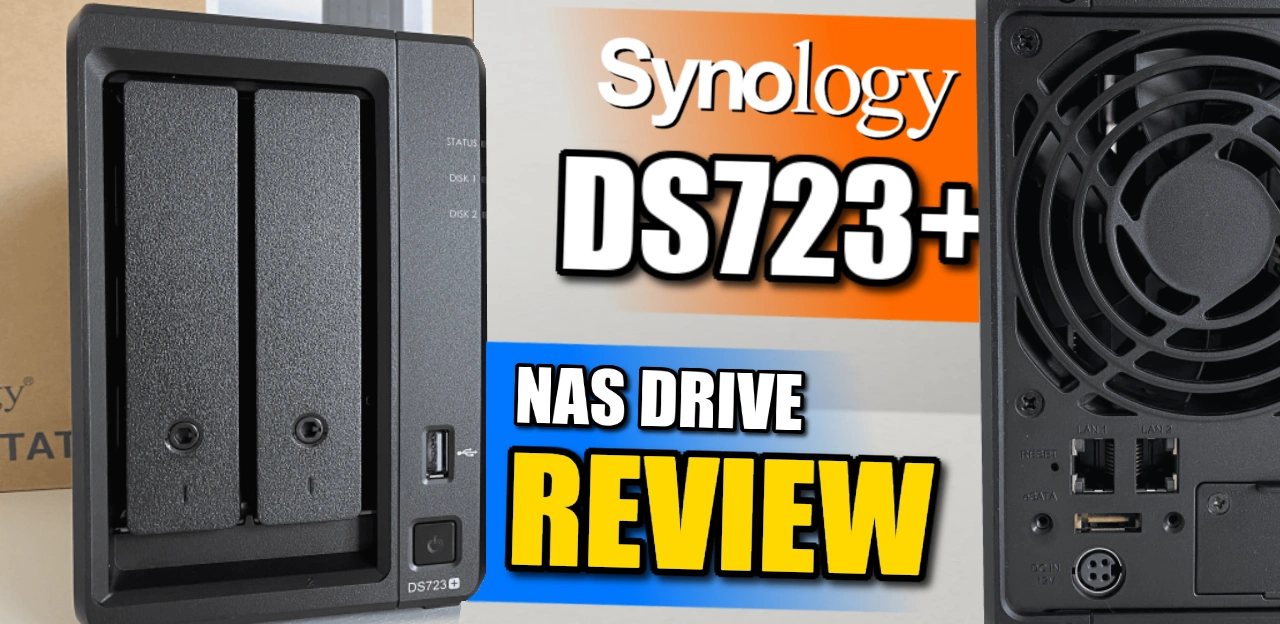




We need nases with intel 13500 cpus in them set to a low power mode to have god tier av1/hevc nas/plex all in one servers
REPLY ON YOUTUBE
This channel isn’t getting the attention it needs guys !! Too many useful content
REPLY ON YOUTUBE
If I’m on a train with so so signal and I want to stream a lower quality version, transcoding down from 4k, this just won’t do it. It’s shocking really considering a £38 Raspberry Pi 5 does it with ease. So I had to install Plex on my Pi and mount my Synology on it, very disappointing though for a £450 NAS enclosure…
REPLY ON YOUTUBE
Sry Plex is lame, use Jellyfin, is opensource, no online account oder sub. ????
REPLY ON YOUTUBE
I need ecc for zfs. Done.
Plus, I want the power. I can stick a little cheap GPU in of needed and it’d be way more powerful.
REPLY ON YOUTUBE
Thank you for this detailed overview
REPLY ON YOUTUBE
Forgive the stupid question, but for the 4k trailers if you were playing them on say the Plex app on the Chromecast with Google Tv, you wouldn’t encounter any of the buffering issues since no transcoding is needed right?
REPLY ON YOUTUBE
Thank you for the video. Could you please compare the Synology DiskStation DS723+ and ASUSTOR LOCKERSTOR 2 Gen2?
REPLY ON YOUTUBE
after watching this, i just hope ugreen wipes the floor with synology
REPLY ON YOUTUBE
Question some of the new models do have Intel Celeron. Do those all have the same imbedded graphics as this older model ?
REPLY ON YOUTUBE
Synology really went out of their way to remove one of the only features that home users care about….hardware transcoding. I hope the Ugreen NASync has good enough software support and apps to kick Synology and Qnap in the asses.
REPLY ON YOUTUBE
this prob isn’t efficient, but could one have a mini pc connected to the nas. the mini pc would have the plex server on it and it would be connected to the nas to have access to the video files. argument there is just get an external hdd enclosure or something, but i counter with what if one still wants a nas for the other applications it offers, but also doesn’t mind having another pc with plex server on it and not caring that the actual nas doesn’t do the transcoding.
REPLY ON YOUTUBE
Seems like these comparisons are moot if you just connect any NAS to a Zidoo media player such as the Z9x or Z2000pro to pull the content from your NAS. Those will play anything smoothly, everytime.
REPLY ON YOUTUBE
I bought DS423+ after comparison reviews from your channel, and watched this video while still waiting for it to arrive. Great job! Is someone at the door? it’s my NAS arrived!
REPLY ON YOUTUBE
You talked too much, Please show your audience more about its functionality or the inside or the new features or how you use it.
REPLY ON YOUTUBE
I have a DS 720+ and Jellyfin installed. When I turn on subtitles on my LG C1 it no longer plays or it very slow to load. Any ideas what it could be?
REPLY ON YOUTUBE
Had this on in the background over a couple of days. This is the comment you requested — I made it to the end! =D
It’s definitely not in the budget for me yet, but I’m dreaming about a NAS in my setup in the future!
REPLY ON YOUTUBE
Cant wait to get one on the cheap to use as a torrent server ????
REPLY ON YOUTUBE
Seaguls playing with your lights now?
REPLY ON YOUTUBE
Thank you! It’s the first really comparison for the 2 NAS
REPLY ON YOUTUBE
100 mbps is not crazy, my 4k remux of “eternal sunshine of a spotless mind” is 93 mbps on average. I do have a shield pro on my main TV, but not all my devices can direct play everything nor all of them are 4k (my cellphone and laptop are 1080p). I don’t want to have 100% CPU usage just to play a single file. My GTX 1650 does this at 1-3% usage using nvenc reading a 5tb usb 3 drive, it’s still a better option to configure my local PC as “wake on LAN” to play content.
REPLY ON YOUTUBE
I don’t understand why you would not want to optimise your CPU performance with SMT. It’s basically just saying you’re happy to have your CPU sitting idle instead of working, for a slight improvement on task completion times.
REPLY ON YOUTUBE
Would the 723+ be a better one for watching videos at home using DS video? Or would it give the same results as using Plex? Thanks
REPLY ON YOUTUBE
You just earned one subscriber more! After watching full video I decided to buy ds720+, it’s for home use, storage and multimedia in general.
Also I was looking for adding in WD Red Plus drives. Pro would be too expensive and basic Red is too slow. Red Plus it’s looking like sweetsop for me.
What do you guys think?
REPLY ON YOUTUBE
i did watch the whole video
REPLY ON YOUTUBE
Hello, can I use SSD disks to store information instead of HHD disks in this model Synology D723
REPLY ON YOUTUBE
Great content! Thanks for your time and experience!
REPLY ON YOUTUBE
Why can’t Synology get with the embedded graphics program! If QNAP interface and software was more user friendly. Synology would really have problems.
REPLY ON YOUTUBE
Here for the pictures of Nas, staying for DS723+ review
REPLY ON YOUTUBE
I’ve seen reports of using the read-write cache option causing the entire raid volume to crash if an ssd fails, so I’m personally going to be sticking with the read cache only.
REPLY ON YOUTUBE
How is it with synology surveillance station software and H.265 and H.265+ video encoding on DS723+?
Hey guys – really good video. I really researched this topic a lot and decided against the 923+ or 723+ due to dual core and no embedded graphics. I will tell you though, the the 1500B Ryzen in the RS1221+ is a beast. It is by far the fastest NAS I have. My RS422+ has the Ryzen 1600 in it and I’m not super impressed. Most home users are not going to benefit from 10GBE yet because everything else in the house runs 1GBE or less. I’m sticking with the DS920+, DS720+, and RS1221+ for now and skipping the 23+ series. I think Synology really let us down on this one. Also, the hard drive selection on these from the QVL is getting stupid for something that crosses between home and business NAS for the home user who wants more power.
REPLY ON YOUTUBE
Hmmm ….. ; In a nutshell, DS?23+ don’t-dos real-time transcoding well at-least compared to the DS?20+. However none-trancoding multi-media pretty-much works fine.
Sooooooooooooooooooooooooooooooo ???Hows-dos I avoid real-time multi-media transcoding then (ex: don’t curse the darkest but light a candle)???
For ex: anticipate all desired multi-media formats/standards & transcode each multi-media file ahead-of-time ; off-load transcoding to a laptop/desktop when available ; transcoding within SSD storage ; profinity/throwing-thing/praising at the DS?23+ ; complain/whine to Synology until they fix the darn problem ; etc 😉
REPLY ON YOUTUBE
I watched a lot of your videos and the best solution for people wanting Synology and also want to do things like Plex, is to just run Plex on a separate device that is more designed for this. I don’t use Plex, but run Channels DVR that does do transcoding in some situations. I run it on a 10 year old Mac Mini which is a totally silent inexpensive box that relies on the Synology NAS for 20-30TB of storage. Let the NAS do what the NAS does well, and run CPU intensive processes on something else. This should outperform running it on any NAS. Maybe a good test for you to do in the future is to compare Plex running on a NAS (any of them) with Plex running on a Mini or NUC, and using the NAS just for storage. I’m guessing that will perform better.
REPLY ON YOUTUBE
really liked your videos man. i’d like to seek your advise on using plex on the 723+. can i just turn off transcoding in plex and expect a better speed and quality experience? I am looking at just storing 720 and 1080p videos on the NAS
REPLY ON YOUTUBE
This unit is such a Disappointment! I was so excited to upgrade my DS214Play with this unit. Then everything about it became an absolute disappointment. For the past 15 years I’ve used two different Synology units the same way. Main unit for storage and an external eSATA enclosure for backup (single version). That way at any point in time I had an NTFS copy of everything.
They decided to lock down this unit and the eSATA port is only for Synology to use. It is not usable by the user. That leaves only one USB port. Gees! Even my DS214Play had 4 usable ports on it! Further more the USB port is slower than eSATA. So this unit is a downgrade in that regard. Now add the fact that the dual NVMe slots cannot be used as storage space unless you way over spend on Synology owned drives. Ok, so I’ll use that for cache. NOPE! It’s not cache. It’s some useless smart cache that is only used for frequently read or written files. Completely unlike literally every single cache found on any raid array controller which does both that and acts as real write cache. Then onto the last disappointment. I’m using newer 6TB Seagate Exos Enterprise drives with this unit. Very fast drives. With the 10Gb adapter installed I expected to get a good 500MB transfer speed. NOPE! Starts out at 500 then quickly drops to around 140. Why? This makes no sense. That drive gets over 300 from drive to drive in a PC over a 6Gbps connection. Should be the same over 10Gb. I borrowed a QNAP NAS from someone and set that up. An entire 20GB file transfer saw an average 480MBps (with cache). Yet the DS723+ only averages 218MBps (with useless cache).
Such absolutely pointless decisions on their part. Ah well. I should have held off longer and waited for a USB 4 storage option as this unit is a complete and utter disappointment!
REPLY ON YOUTUBE
Thanks so much, Rob. I learned a lot about limitations. Makes me wonder what the bit rate limitations are on my 920+. Thought the buffering during 4k web- based playback was due to slow upload speed. Perhaps is the 920+ itself.
REPLY ON YOUTUBE
I just purchased a 723+ and a pair of 12TB drives. Did I make a mistake? What would you purchase instead, staying in the Synology family, DSM is the requirement. I am not going to use Plex ever, It will be mostly used for personal cloud and Synology Photos for local management of my family’s photos’ and videos.
REPLY ON YOUTUBE
a very good discussion. I think it would be very good for your audience and newer ones as well if you made a list of the major set top boxes, major phone or chips in phones, and whether they can decode hevc and 4k hevc. Like shield, cube, google tv dongle, fire tv, iphone chip, pixel chip (i forgot what both run on), snapdragon xyz version. Then you can just point people to the page or maybe a shared google drive doc so they’d have understanding as to if they device they’d be sending a file to can natively transcode and make sound purchasing decisions.
REPLY ON YOUTUBE
TL;DW: No iGPU, unfit for purpose.
REPLY ON YOUTUBE
Hi everyone.
I recently purchased a DS220+ and put 2x6tb hard drives in it. I take videos and pics on my iPhone (in 1080 HD) and I also take RAW pics with my Nikon camera.
I want to store all my vids, photos and files on the NAS and then access the NAS to then download media, back onto my phone or iMac/PC, so I can edit the footage and upload it to social media, YouTube etc..
I don’t need PLEX or what have you. I have simply run out of storage on my laptop and phone and need to free them up to take and edit my most recent content. Perhaps if I can play back a few seconds of a video to see if it’s the one I’m looking for will do.
Is the NAS I bought suitable? I have a week left to return it if not but haven’t got it up and running yet.
Cheers.
REPLY ON YOUTUBE
even if you ignore the integrated graphics the CPU only scores 9% higher than the 2020 model lmao what were they thinking?
REPLY ON YOUTUBE
Synology just handed the home market to QNAP. I have a DS-920+ but won’t be replacing it with a NAS that does not transcode. Even if your local playback hardware can handle H.265, try it at your friends house over the public Internet, where it will probably transcode due to server side upload speed limits. I like DSM, but not that much!
REPLY ON YOUTUBE
I can see the DS923+ tempting a power user with no interest in video, getting four bays, RAID 5 and the 4Gb ram. But the DS723+ is only slightly cheaper for a lot less. Who is this marketed at?
I think we might see a DS725+ by the end of 2024, complete with embedded graphics. Unless the lower end 2023 plus series have something on the way…..a replacement for the Play series maybe.
REPLY ON YOUTUBE
Thks
REPLY ON YOUTUBE
The Sin-NO-Lo-sh*t DS X23+ series is done for– and they have NO product in their line up that is feasible once they killed off their 920 straight up BS they could have kept some INTC options until AMD had GPU support. Was seriously considering 220+ as the hardware to value is fair but still too weak and underpowered as plex box & dont look like it will support 265 4k. And this guy with the seagull sanctuary always so neutral yo you know this is BS you can not tell me its ok b/c of business use that synology couldnt spend the extra 20 nicker to put a GPU in it… that like buying a lambo— and then saying we dont need an AC this is an insult. Gonna get QNAP TS 464 as soon as I get paid, i’ll take my chances but at least i wont feel like i got robbed.
REPLY ON YOUTUBE
You always focus on 4K and HEVC. What about transcoding of H.264 Bluray to mobile due to limited bandwidth? This is a far more frequent use case for Plex users watching their server remotely…
REPLY ON YOUTUBE
What do you think about TS-1232PXU-RP ?
I would use Kodi on my big collection films, Series tv. This nas have 12 bay.
REPLY ON YOUTUBE
AMD has many affordable, power-sipping APUs that have strong VEGA integrated graphics. If Synology paid extra $20 on its CPU, DS723+ would have been great for everything. They lost their own reputation by this 2023 release.
REPLY ON YOUTUBE
I’m sorry to say this but paying 500 – 600 dollars plus disks plus ram and not to be able to play a 10 seconds hevc video is ridiculous. It adds a mental burden to the user’s mind to find and play only h.264 videos… Synology screwed its customers in sooo many ways. 2 core cpu, not graphics card, only synology memory, only synology ssds, only 1gb ethernet, expensive 10gbt extention cards….
Thanks for the video my dude!
REPLY ON YOUTUBE
The 720+ is way better buy
REPLY ON YOUTUBE
I should give up on flogging this particular dead horse. Its rubbish for home users. No integral graphics so its basically useless. Who’s gonna risk those times when you need that IG chip. Its like buying a car with only a handbrake. It will stop…… but……
REPLY ON YOUTUBE
How this doesn’t have more likes is unjust. He covers so much and shows great examples. He also has time marks for reference. Great resource! Keep up the good work, would give you more likes if I could.
REPLY ON YOUTUBE
One thing I wish sonology would do especially further backup program is allow you to back up to a networked windows pool drive aka the NAS sync with networked multipooled Windows drive giving you to a form of backup even if you cannot see the data on the Windows pool that be fine if it was just an encrypted image or better yet allow the damn system to read Windows pool drives…. You’re plugging a USB hub with all your USB drives the nas makes its own virtual pool out of those drives and then it backs up just in case there’s nobody has a single 60 terabyte drive …. The fact that most people are coming from multiple hard drives externally to Nas and can’t use those multiple drives as a single pool backup is annoying especially when there’s hard drive crashes or or anything like that at least you’d have a personal backup I didn’t even pay 10-15 dollars per drive one time fee to make a pool for image backup
I literally had to Jerry rig using always-sync to back up the entire NAS drive on a 9 hard drive pool on the Windows side
REPLY ON YOUTUBE
Insert the biggest thing I hate about Synology outside of their “hard drive requirements” (if the damn hard drive says Nas supported then it should just work you shouldn’t need a specific hard drive) is them telling you where to put your media or files for specific programs they own you should be able to tell the programs just like in Plex where the files are where you wanting to put the files and have one way think as an option with no deletion
REPLY ON YOUTUBE
I personally find it difficult still for a novice user especially for making user accounts … Aka having public and private folders for individuals in a group setting (you can’t have both) we’re in the group setting everyone has the rules AKA right and no delete for public folder and the ability for only individual users in that group to only see their private folder and not everyone else’s
Aka private “Jon” public “all” private “Sarah”
John can still see Sarah’s folder
Because I haven’t nested in an outside folder public and an outside folder private where all their names are in the private folder so it’s nice and organized
But everyone can still see everyone’s folder I’d love to have it so that you can easily isolate nested folders
REPLY ON YOUTUBE
One application they should make is a network photo slideshow screen saver picture frame app with dslp and outside network
REPLY ON YOUTUBE
The one and only thing I don’t like about Synology multimedia apps or drive apps…. Is they TELL you where to put your media AND GENERALLY HAVE TWO-WAY SINK AS DEFAULT
Most users are going to have a plexa library that they’ve probably customized and should customize in one bulk “media folder” and then break it down within…. If you do stuff like that for all your multimedia they’re native apps don’t work you have to have it where they want it…. Same with sync you have to have it where they want it and it’s only sync … Me personally I want one-way sink data goes on the NAS … You can delete it off the phone or computer and that won’t transfer over…. They have improved the drive application but I still have to improve video photo and the other ones to be one way and for us to control the locations multiple or single nested location I don’t want to be told or you got to have it in the ” home /user /names/ photo/ to have the photo application work
NO I want to have it in plex media / photos/ cell phone 01/
REPLY ON YOUTUBE
why do I need raid 1 on the ssd cache? It doesn’t matter if the data is gone on the cache if one ssd fails. The data is stored on the HDD after a Data is altered in the read/write cache. or is written again from the HDD when a new SSD is added. So that makes no sense. Raid 0 would be better in this case.
REPLY ON YOUTUBE
Seems that synology still isn’t serving a high end consumer 2 bay for all the plex people. Need to find out what the best is cause i think 99% of the people interested in this have that as the primary use. Seems dumb to not have a cpu good enough to do the hevc transcoding.
REPLY ON YOUTUBE
I so remember when Illmatic hit in the 90s. I was i college. Legend. What’s wrong with 99 Problems. Still a nasty beat and a great song. As for Jay v. Nas. I like em both but Ether was nasty. Bodied him on that one.
REPLY ON YOUTUBE
How does the DS720+ compare to the DS723+?
REPLY ON YOUTUBE
you are missing an important point at 27:40
they dont need to increase the price to add 10Gbe network ports, they actually spend extra money so you DONT HAVE 10Gbe ports by default.
The CPU in this NAS and in all new Synology units natively supports 2x 10Gbe.
All they need to do is wire it to ports and thats it.
They spend extra money to add a 2x 1Gbe NIC which the CPU does not support but that extra money is well spend for them because that way they can sell you an overpriced 10Gbe NIC afterwards.
This needs to be said in every single video about any new Synology NAS as this is extremely anti consumer
REPLY ON YOUTUBE
Been lurking for quite some time while our google photos storage fill ups. Gonna be a first time buyer and interested in this model. Is it overkill for automated backup from two phones for photos and maybe security camera back up as well?
REPLY ON YOUTUBE
Looks like Synology just wants to capture users in their DSM walled garden, then gouge them for their overpriced, inferior proprietary hardware. No thanks.
REPLY ON YOUTUBE
Thks & sorry I thinks Eddie & the sea-gull are right for a home/family NAS.
REPLY ON YOUTUBE
Just upgraded from a DS1812+ recently and ended up with DS920+ instead of the 923+ purely because Synology opted to use an iGP-less chip for the new generation. There are ryzen embedded chips with igp. So disappointed with Synology for cutting out the igp in their new prosumer models.
REPLY ON YOUTUBE
@NASCOMPARES I would be interested in seeing the 923+ against competitors that sports an AMD processor to see how they compared with file IO. I suspect they would be close, and I wonder what the price differential would be?
REPLY ON YOUTUBE
It’s the same shit like ds923+ for home users. Also the expensive Synology rebransed componenrs (ssd, ram, 10gbpe)
REPLY ON YOUTUBE
Features important for me:
– Immutability
-Object Store
– Scale out / Web Scale
– 10/25Gb Support
These are all features that are requred for large scale Backup / Archive, we have them using other very expensive enterprise solutions, but as an entry level system for medium size clients would be cool.
REPLY ON YOUTUBE
I understand that Synology have to hit an appropriate price point with their 2023 NAS devices, but for the same price one can buy a considerably more powerful QNAP. I would like to have a NAS with Synology software and more powerful hardware. I would be happy to pay more for that. Unfortunately, Synology don’t seem to offer this in their latest hardware.
REPLY ON YOUTUBE
720+ is still the better one. 4 cores 4 threads and i run my with 18GB ram…
Better as 723+ with only 2 cores… Sadly no improvement. So all just buy a 720+
REPLY ON YOUTUBE
Wow. Synology DS723+ is a collection of avoidable annoyances to leave buyers hesitant and dissatisfied. Could have been great. Could have been acceptable. But, instead, is unnecessarily disappointing.
REPLY ON YOUTUBE
For me would be interesting the 2.5+ gbe, the cpu is a step back, especially with the higher tdp with lower multicore performance. They should use a newer, more efficient cpu.
REPLY ON YOUTUBE
You never mentioned power consumption (i dont think?). When compared to the ds720, which is best on purely power usage over a 24/7 period? I am looking at a 2 bay solely to run my ip cameras 24/7. My 1821 would do everything else. So I’m happy to get the 723 (as the newer unit) if power consumption between the two is negligible.
REPLY ON YOUTUBE
Thks & DS223+ or ?bust? (fingers-crossed 😉
REPLY ON YOUTUBE
I found it funny you had the 10Gbs OPTION as a big positive, then you were pissed off at the end it wasn’t standard. Love your vids mate, you are the real NAS master and I’m sure you’ll rate higher in google than that rapper in a couple of years! 🙂
REPLY ON YOUTUBE
Proprietary is a non-starter when it comes to storage
REPLY ON YOUTUBE
**Help Needed**
I have several Apple products and a big PC. I have several 1-2 TB hard drives full of over a decades work.
I’m about to start a business that will be 4k video (1080HD) and picture heavy for media presence.
I took out a 3tb Drop Box account but hate the Drop Box interface and have been flirting with the idea of buying a NAS system; 2 x 4 Tb’s to start with.
Was looking at Synology 2 bay. Could not decide between the 20+ or the other model (around £175). Deciee to wait for the new 2 bay with USB C etc.. but it seems that’s been a bit of a blow out.
What is the best path forward? I don’t want to be too complicated. I just want to store all my stuff in once place and be able to access it across platforms (Mac/PC) and move on with my life, instead of having drawers small HD’s and an annoying drop box that I’m near filling up anyway.
REPLY ON YOUTUBE
Glad I Grabbed a 720+!
REPLY ON YOUTUBE
So glad I purchased the DS920+ and will be using this until its end of service life…then goodbye Synology, hello QNAP
REPLY ON YOUTUBE
QNAP allows using EdgeTPU on the m2 slot. Does 723+ offer such a possibility?
REPLY ON YOUTUBE
You wasted 3 minutes of my life with the artsy-fartsy intro. Stick to what you do best.
REPLY ON YOUTUBE
I love you man your the white noise for my bad time.
REPLY ON YOUTUBE
I bought DS923+ a month ago as a replacement for my aging DS414 and couldn’t be happier with it. All I need is a fast and reliable file server. With 10GbE add on card I can access the volumes as if they are internal PC drives. And I work in VFX business so I’m hitting my NAS hard all day. Couldn’t care less about the plex (which is fine with H264). I don’t understand what the fuss is all about. This is NOT a product for home users wanting a media server. This is a fast business file server. And it just works. Set it and forget it. And what all that QNAP OS crap I wouldn’t touch it if they were free.
REPLY ON YOUTUBE
Synology lost me when their removed their USB DAC/Speaker Out functionality. That was really the only reason why I stayed with Synology because it functioned as a beautiful control for my hifi and streaming. It was all so nicely seamless. Removal of this feature basically freed me from Synology. I no longer have to stick with it and accept all those limitations described in the video. The world opened up.
REPLY ON YOUTUBE
I have returned my 1522+, the value is not there.
I did prepared 32 gb ddr4 Kingston (2×16 Gb), with 2 x 1Tb Samsung 980, for pool storage, 4 x 8 TB Seagate and 1 x 16 Tb Toshiba.
After setup I’ve received a notification about my ddr4, then for my pool M.2 drives,
then even for my Seagate 8 Tb HDD’s, that all are not compatible.
Nas was working but like this – no thank you.
There is no value for it, at least for me.
REPLY ON YOUTUBE
I need more breakdowns of Rob compared to other hip hop artists circa late 90s to late 2000s.
REPLY ON YOUTUBE
Proprietary stinks
REPLY ON YOUTUBE
Only:
1 GbE ports!
1 USB port and only 5Gb
2 Gb memory
Only Synology NVMe disks
No PLEX support
It’s a joke!
DS723+ should have been named “DS723- – -“ and priced much lower
REPLY ON YOUTUBE
NAS is an alien to me. I would like to build my home photo server. Based on my reading, Synology has the friendliest server & client apps for this feature. Is that right?
REPLY ON YOUTUBE
With every new device Synology release, I get more glad I bought a DS920+
REPLY ON YOUTUBE
Will not buy Synology. So dumb.
REPLY ON YOUTUBE
I only have one thing to say, 32GB of ECC Synology memory costs more than the Nas itself.
REPLY ON YOUTUBE
Think they have shot themselves in the foot, this one is not for me!
REPLY ON YOUTUBE
Synology , artificially hobbled this drive, and that’s not good business for their customers…
REPLY ON YOUTUBE
Great intro ????
REPLY ON YOUTUBE
As a home user I wasn’t “a little bit disappointed” with the CPU I just ruled it out instantly, same with the 923+. Also as home user have 2.5 let alone 10Gbe is an irrelevance as is ECC. I play Plex and I view photos and store the off files. I don’t use mobile so everything I play is at home, through the latest Apple TV+ 4k so in practice the 723+ will work fine as the Apple TV+ handles everything but it’s still a show stopper for me…because for me its a step backwards. However, I still watch videos from you like this as they are so informative. Keep it up
REPLY ON YOUTUBE
Sounds pretty low compared to QNAP 253 and Lockerstor Gen2 Drive, Very disappointing
REPLY ON YOUTUBE
Thank you for this Video!
REPLY ON YOUTUBE
Does DS723+ support 64GB ram?
REPLY ON YOUTUBE
Funny how that Security Advisor isn’t barking at you for having the standard 5000 and 5001 ports in use. Mine’s been yelling at me 24/7 about it.
REPLY ON YOUTUBE
That really is an in-depth and thorough review. I’ve had the DS1621+ for about a year and you’ve helped explain what some of the apps actually do. Thank you.
As a photographer using Lightroom to manage my my photos, I still cannot understand why I need Synology Photos or S Video to manage them?
REPLY ON YOUTUBE
Thank you for the detailed review. I am interestedin buying a new Synology Nas (920+) and i own an old XP 32 bit PC do you think there will be any issues about compatibility from Win XP 32 bit to the DSM 7.1 Synology NAs, in that case does any workaround exist?
REPLY ON YOUTUBE
Synology could have used 1605 chip with integrated graphics and had AMD hardware transcoding for a couple of extra dollars, instead crippled the DS21,22,23+ models for plex
REPLY ON YOUTUBE
TBH I am a little confused, I need a NAS for file back up Documents, Heavy photo storage and fast download retrieval of images, as well as secure storage? One possibly two users at home, small business 720 or 723? Thank You.
REPLY ON YOUTUBE
I’m the one who watched the whole thing! And some bits twice. Very helpful in trying to decide between a Synology DS923+ and Qnap TS464. Synology seems to have the upper hand software-wise which I suspect carries more weight for a home user than the superior hardware of the Qnap? Thank you for providing this extensive review!
REPLY ON YOUTUBE
My dude, another spot on video – can guarantee you have helped more than one person make an informed decision.
I have been holding and holding with my 214play (bleh) to see what XXX23 brings and it looks like XXX20+ is still the answer for the prosumer/transcode user.
Perfect level of information and impartiality (I’d call the new releases a hot steaming pile, but that’s just for my use case) – lets hope they’re not gearing up for a quad core DS923+Play++GOTYE+Platinum+++++ with an onboard graphics!
REPLY ON YOUTUBE
Awsome information. Now please a similar video on Qnap. I cant make up my mind as I need both photo management and video surveillance. It seems like Qnap and Synology takes 1 point each.
REPLY ON YOUTUBE
Jellyfin?!!! Most channels that review media server software, either only deep-dive their preferred offering, or only give an overview compression of the field. If someone like you, who can give the same enthusiasm creating two videos deep-diving two NASs that only differ by a drive bay, puts that into a spin-off series on a topic that is close to a large chunk of your demographic, that would be a real treat.
REPLY ON YOUTUBE
Thks & I just watched it again & most excellent;
I’m a retired physicist & have no real problem understanding the infinite details.
However my problem is how to keep it simple & stupid (ex: high tier levels of simplicity, brevity, encapsulation, etc).
Oh with my goal is to sociably knit-together all my family, relatives, friends, etc on my synology NAS.
Unfortunately I’m going to be Mr Tech support for them. Sooooo I gots-tos keep-it-simple is an understatement & I will be abused (I says anything for family/friends though ;).
REPLY ON YOUTUBE
I’m also only seeing 360. Can’t make out any screen. text
REPLY ON YOUTUBE
You’re a DSM PhD;
I never hear so dense of a presentation of great DSM info & my head is still spinning, thks.
Next-time, you think about having something good to drink every-once in a-while.
REPLY ON YOUTUBE
47:05 Where, When
REPLY ON YOUTUBE
Still only 360p for me
REPLY ON YOUTUBE
Still just in 360p
Hope it will fix soon.
Thx for all the effort!
REPLY ON YOUTUBE
Watched you video from begin to end! Loved the deep dive into DSM, since I am looking into buying a new Synology. Keep up your amazing videos!
REPLY ON YOUTUBE
Nice video. Does anyone know why my USB printer doesn’t work anymore on my Nas Synology ?
REPLY ON YOUTUBE
Thanks for a great video. Really explains what everything is. Recently got my NAS and been already updating hard drives in it. It will mainly be used as a PLEX Server but already considering what i will do when i start upgrading the smaller drives in it. May consider another NAS and use it as strict data back up and maybe a synology Drive / synology Calendar and Email setup. Move my calendar off Google’s stuff. We will see If i do that at some point. Great job again
REPLY ON YOUTUBE
Thank you for all the work you put into this. Very helpful.
REPLY ON YOUTUBE
920+ for me !! , I some times I do not understand Synology ?! just upgrade the Intel Cpu with 4k support and you have ours wallets !!
REPLY ON YOUTUBE
My English man!!! What a video! Greetings from Greece! I really appreciate your hard work and that content. I have a DS 1520 + and I am not regretting getting it although the new 1522 is out. You have my admiration. Keep up the professional and good work.
REPLY ON YOUTUBE
Why only 360p is showing ????
REPLY ON YOUTUBE
Would it be too much to expect something similar for QTS?
REPLY ON YOUTUBE
Why 360p? Can’t see it clearly.
REPLY ON YOUTUBE
Wow ! What an episode – a full tutorial for everything ! A one stop shop – Thanx Robbie ‘ol mate !
REPLY ON YOUTUBE
Yes was wondering why its. 360p till saw the comments
REPLY ON YOUTUBE
*Note* – Regarding picture quality, this is a BIG video (so many features to cover in a single video) and YouTue can sometimes be a little slow to process HD and 4K uploads, so if this video is in low-quality for you, maybe come back in an hour or so, as YouTube should have finished processing it and have the 4K, 1080p and 720p versions done. Thanks for watching and hope you enjoy the review of Synology DSM 7.1, featuring the DS923+ NAS.
REPLY ON YOUTUBE
Eddie participation is really good, I was looking for a home NAS and he made some good points for the 720+
REPLY ON YOUTUBE
Thks, NAS Nerds
REPLY ON YOUTUBE
the 920+ has some stuttering during playback. it wil just freeze for a tenth of a second during playback (like the spiderman-scene at 8:40 when they’re talking, 8:49 with the large screen, at 9:00 during the fade-in). That would be unplayable for me because it’s very noticable and annoying. Could it be that the settings were wrong for playback in plex? That it’s playing back in 24p instead of 23,997p and that’s why you get stuttering?
REPLY ON YOUTUBE
Looking to upgrade my 1515+. Looking at 1522+ or 1621+. Is the 1621+ worth the extra $200 (cdn)?
REPLY ON YOUTUBE
The Synology DS923+ NAS Review is now LIVE! Find it here – https://nascompares.com/2022/11/16/synology-ds923-nas-review/
Find Blackvoid’s review of the DS923+ NAS here – https://www.blackvoid.club/synology-ds923-review/
REPLY ON YOUTUBE
The Synology DS923+ NAS Review is now LIVE! Find it here – https://nascompares.com/2022/11/16/synology-ds923-nas-review/
REPLY ON YOUTUBE
right guy is right
REPLY ON YOUTUBE
723 is just way better
REPLY ON YOUTUBE
I absolutely LOVE my 920+. I have had zero problems for 3 years now.
REPLY ON YOUTUBE
Ah so the local Seagulls are Mac users?
REPLY ON YOUTUBE
macOS = Carbon Copy Cloner! Bootable backups to RAID1 eSATA external device. Data – ‘cold’ backed up to NAS / remote NAS / SynologY C2 Cloud. 3-2-1 backup.
REPLY ON YOUTUBE
Where is DVB-C support? this is going backwards…
REPLY ON YOUTUBE
Luka could use a proper mic. I found it tough to understand him most of the time with that iphone earbud mic. Very muffled.
REPLY ON YOUTUBE
Robbie, first it was Rooter vs Rowter. And now you’ve thrown a spanner ( that’s wrench to the Rowter crowd ) into the works with Beeta vs Bayta. And next, will you hate Shit hawks or Shite hawks ? I can’t take it any more. I’m going to head down to the local for a poynt and maybe stay for the carvery.
REPLY ON YOUTUBE
ds1621+ vs ds1522+
Things that important for me:
– surveillance station
– google photo replacement.
– ecc memory
– maybe iscsi/file storage
– full size pci slot for sfp+ is a bonus but not the main concern
Which cpu is better for this scenario?
REPLY ON YOUTUBE
As a long time Synoloy user (DS211, DS115j ,DS718+ ,DS220+) I am really get tired of waiting for an affordable 2-bay + SSD model with a 10/5/2.5/1 gigabit interface. I have a QNAP Ethernet 5Gbps USB adapter on my DS718+ (thank bb-qq/aqc111 ), but a properly supported solution is long overdue. Not to mention, while announced for DSM 7, SMB multichannel still seems to be unavailable. Starting to wonder if I should be looking more carefully at the competition.
REPLY ON YOUTUBE
Ok. @ about 5:12 or maybe 5:13, 5:14, it sounds like someone FARTED!!! ????????????. Listen to it. Someone let a stink bomb out of their ass????. And don’t say it was seagulls. ???? too funny. Anyway keep up the great work. I am a server nut. I have 4. Though I retired 1 of them.
REPLY ON YOUTUBE
I have to say I found Luca audio quite muffled compared to yours. It was tricky to understand him in parts.
REPLY ON YOUTUBE
Also – for those who are wondering where Eddie is… HE is the one sending messages (the notification noises) later in the video that I am desperately scrambling to disable (and failing). He says Hi btw…
REPLY ON YOUTUBE
No ds1823+ news?
REPLY ON YOUTUBE
*IMPORTANT* – Few disclaimers on this vid! First off, Apologies for the sound de-sync in 3 areas(especially in the first 15 seconds), this was largely unavoidable due to the constraints of recording the zoom audio and not using a 3rd party recorder. Next, We mention this several times, but do not be surprised if several of the features covered are eventually rolled out as features independent of DSM 7.2. The last point, sorry this vid has taken longer than it should (Synology 2023 and Beyond was 2 weeks ago!) but I judged coverage of the new Synology DS923+ that emerged at the same time as the thing you guys would want to know more about first, so I prioritized that. Hope you like this long-form discussion and mashup of NASCompares and Blackvoid. If yes, we hope to do more in future!
REPLY ON YOUTUBE
I’m sorry but this videos is just misinformed. The integrated graphics are not used for transcoding. There are dedicated chips for this purpose. The memory is a huge boon and the base model wattage is 15 not 25. They could have stuck with Celeron but the amd isn’t bad and was specifically created for embedded unlike the celeron.
I think it’s a smart move
REPLY ON YOUTUBE
Great video ????
Was wondering if you have a link for that video trailer which you showed last? I believe it was a Hevc 4k
60mb/s ?
Would like to DL it and try some tests on my end !
Cheers
REPLY ON YOUTUBE
Thx for the comparison, Apple Studio with a MikroTik Cloud Router Switch 305-1G-4S+IN here i come!
REPLY ON YOUTUBE
To keep it short… both are not worth to buy :-/ …i have no idea why Synology don’t use GPU with the AMD.
REPLY ON YOUTUBE
Need Help!
My turn finally to buy a NAS and money isn’t an issue.
I edit 4k multi cam vids all day long and need to work off a NAS that has caching etc. I will need raid to back up work just in case of storage failures. My vid and clips and data are at the moment at around 15T so want a system that can handle that, back it up, and extract the data whenever I need with fast speed.
Again I want the best, something that will last years and not something that will be outdated any time soon.
Speed is the key for me though.
Thanks
REPLY ON YOUTUBE
Changed from. 1817+ to 1821+ resulted into 3.5gbit to nearly 7gbit performance of a single 10gbe copy from my pc
Same Intel card, same hdds… Just the Nas changed.. Thanks ryzen…
REPLY ON YOUTUBE
*Intel Celeron J4125* : _Release Date Q4 2019,_ 4-Core CPU with Integrated Graphics (Synology 2020 NASes)
*AMD R1600* : _Release Date Q2 2019,_ 2-Core CPU with no Integrated Graphics (Synology 2023 NASes) Progress ? ????????????
REPLY ON YOUTUBE
what about the speed of searches? If I have 3 users searching thousands of folders/files which NAS will hold up better to running the INDEX services using file content (not just file name searches) with the least delay?
REPLY ON YOUTUBE
Is there any official date for end of support for ds720+? Or can we estimate this?
REPLY ON YOUTUBE
Thank you for this video. It was a big help in making my decision to buy the DS920+. It’s a great NAS and I am so happy I bought it.
REPLY ON YOUTUBE
The *23 series seems to definitely be the “skip” generation until Synology comes back to their senses.
REPLY ON YOUTUBE
Love the work guys. I’d like to hear your thoughts on – home video.
We are an iOS family. We record video at 4K 60 FPS. A three minute video can easily be north of 350MB.
I have a 918+ and it struggles to to play the home videos. Some just will not play.
I’m keen to upgrade, I enjoy DSM, but I feel like the new Synology offerings will not work for me.
Can you do a video discussing home video played through Synology Photos?
Would love to hear your thoughts/findings as I may be doing something wrong????
REPLY ON YOUTUBE
Have both Nas. DS920 for Plex and remote Back up/rsynce the DS923 for files transfer storage, surveillance/VM & etc.
REPLY ON YOUTUBE
2 bay NAS just don’t seem a good value proposition compared to 4 bay NAS.
REPLY ON YOUTUBE
Sry man, can’t hit that dislike you ask for, on any of your vids. Keep slaying the NAS and Sever topics!
REPLY ON YOUTUBE
Great video, as always. Would love to see a review of hubs that offer link aggregation.
REPLY ON YOUTUBE
I would like to see the comparison between DS1621+ and DS923+ and maybe DS920+ in PLEX media. I curently have DS718+ and want to upgrade to something with more bays. I am using my nas for all (PLEX, VMs, Synology Photos, VPN server, ip cam, docker – home assistant, etc), I also have WIFI 6 all around (router, all phones, laptops) so 1gbe starting to be limiting… so I wounder if it is better to buy now DS920+ or theoretically DS1621+ (no GPU, but more horse power)
REPLY ON YOUTUBE
i would argue the 723+ falls flat once price comes into the equation. it offers no benefits other than maybe ecc memory. let’s face it though, this is a device for home and only very small businesses. ecc memory is not a top priority for simple fileserver, some backup and sync jobs, which is what a station like this one will do in an office.
the added cpu performance is completely useless with the network limitation and once you factor in a 10gb addon the price is the point where feasibility falls flat.
what the 723+ has added can not be used in any meaningful way, so the 720+ in practice delivers the same experience for a lower price. it just wins however you look at it.
had they only put 2.5gbit on there the story would be different, but as is, the 723+ is just not a competitve offer in my book.
REPLY ON YOUTUBE
Just got the 720+ for £370, happy with it
REPLY ON YOUTUBE
Power and more memory is largely irrelevant for home uses. Same with nvme speed or more than 1gb ports. Even worse is promoting WiFi 6 which is years away from being a common standard. Who cares ? Lack of integrated graphics makes the 723 pointless. I think you need to clearly separate the two products. They are completely different, completely different.
There is no point in a value for money. No integrated graphics means 0 value for money.
REPLY ON YOUTUBE
So is the 723+ a 2-core or quad(4) core. See timestamp 6:28. Love your channel and have learned a lot, thanks.
REPLY ON YOUTUBE
I enjoy these conversations. One issue that seems to be looming is if Synology alienate the plex home users, how would you go about migrating to QNAP? Would you even want to?
My biggest gripe was always not being able to remove a hard drive from your cluster. This would allow a better way to migrate elsewhere rather than having to buy bigger hard drives for a 2nd system.
I have a 5 bay 1515+ and have no idea where to go from there. Cant go to the 920+ as its only 4 bays, not a huge fan of the ryzen, and unsure if buying the add on machine to populate with spare HDDs I have laying around whether it would remain compatible with future releases.
REPLY ON YOUTUBE
Eddie nailed it, but I think the biggest problem with the “Ryzen is better for traditional home NAS tasks except multimedia” argument is that traditional NAS tasks *except multimedia* are very lightweight. File storage and sharing, private chat servers, pi-hole DNS filtering, Tailscale, etc – none of these are going to see any noticeable benefits for home users by the ‘upgrade’ from Ryzen to Celeron or from ECC memory. But multimedia (which is what most home users buy this for, let’s be real) is getting a huge downgrade.
REPLY ON YOUTUBE
With out knowing the price this is more like discussing the sex of the angels.
REPLY ON YOUTUBE
Just a quick shoutout, my first NAS was a 720+ and I was able to get it going because of this channel and all the info you put out. Thank you for that. I’ve since upgraded to a 1621+ and so far so good. Keep up the great work.
REPLY ON YOUTUBE
Any news on the DS223+ yet? ????????
REPLY ON YOUTUBE
1st
REPLY ON YOUTUBE
Oooooooooooh;
Synology DS1522+ NAS Video Station Testing 4K & 1080p https://www.youtube.com/watch?v=ZLTVjScmU-w
REPLY ON YOUTUBE
i’ve watched your other vidoes of 4k comparasions but these NAS are not able to play HIGH BITRATE 4k content. So if the intel CPU is powefull enough then what is creating the bottleneck? because streaming is mostly IO bound process (as contracy to cpu bound process which requite more processing power) so processorer can’t be bottleneck. what are everyone thought on this?
REPLY ON YOUTUBE
IGP missing is not good
REPLY ON YOUTUBE
Im going Qnap next time. Syno is just doing everything wrong lately
REPLY ON YOUTUBE
Hello guys. I’m really confused ???? I want to buy a NAS but what should I buy? Synology? Qnap? What processor? I want to use it as a media player. Most of my video’s are 4K or 4K HDR/Dolby vision. Please some advice? Thank you.
REPLY ON YOUTUBE
Hmmmm …. AMD is famous for it iGPUs.
???????????Welllllllllllllllllllllllllllllllll why in the heck didn’t Synology just put a AMD CPU with iGPU in their darn home/office NAS???????????? (no entiendo senor 😉
REPLY ON YOUTUBE
I ended up buying the 1522+ as I was hopeful it would have a graphics processor but come to find out that it’s not really needed and not a hill to die on to be honest. Better option is the 10GBE (that should have been included) as a future proof option and more ram. If embedded graphics is a must for plex then just buy a NUC or use a old computer for a Plex server. Most if not all formats play on newer devices so transcoding isn’t needed.
REPLY ON YOUTUBE
I think even the seagull behind Ed was totally unimpressed by the argument for AMD. Of course if Synology’s aim is to have a separate range of commercial NAS and a separate range of consumer, media, NAS then fine.
But they should announce their intentions as I guess half their customer base wants Plex and also 1gb Ethernet and has no use for 2.5 gb or non embedded graphics
REPLY ON YOUTUBE
Trying to “both sides” this is a bad look for your credibility as an independent reviewer. Call it like it is – this is a bad move from almost any angle, and the few advancements in the -23 series are things that could have easily been achieved with a newer CPU with integrated graphics. Synology cheaped out because they got a good bulk deal on low end Ryzen chips, and their product lineup is going to suffer for home users for the next few years because of it.
It feels like you’re so committed to Synology because your YT channel relies on them being successful, so you don’t know how to react to bad decisions like this other than to put on a brave face.
REPLY ON YOUTUBE
14:53 really says it all….
We have no issue with AMD powered CPUs if they would have the same or better GPU power which the R1600 has not… APU NAS when?
REPLY ON YOUTUBE
What is the NAS going to be used for? I think with the support of virtual machines and containers, your NAS can also double as your main home server. If that’s what you’re looking for, I’d say go QNAP.
That’s what I did. I bought the QNAP TVS-H1288x. Yes, it is expensive, but it also serves many purposes in my home. I have a Plex server, along with a Windows 11 and Ubuntu VM running, and a few containers to handle various duties in my house. It has 4 2.5Gbe ports, 2 10 Gbe ports, and 2 Thunderbolt 3 ports for any imaginable network needs you might have. I can still add a GPU if I want and I’m currently only using a portion of the machine’s potential. So I won’t be needing to upgrade this H/W anytime soon.
If you just want a NAS, then the CPUs offered by Synology are more than capable of handling the task. I prefer the Synology S/W over QNAP, but Synology needs to up their H/W game to include at least one 10Gbe port on every model they sell. Buying a NAS today with 1Gbe ports is a waste of money, and quite honestly link aggregation does not do the job. I have an old DS1512+ that is over a decade old and still running fine. None of these new 2023 Synology boxes you’ve been discussing offer much more than that old DS1512+ I already have as far as a NAS is concerned.
REPLY ON YOUTUBE
Would it be a possibility that Synology developed a “graphics card” to plug into the pci-e expansion slot? So you could choose between graphics acceleration or 10G adapter.
REPLY ON YOUTUBE
I just have a separate pc that comes on, on demand for when I need to play Plex media. It boots in 10s so it’s fine. I’ve given up on wanting to use a NAS for videos.
REPLY ON YOUTUBE
Had moved to 1621+ last year, i never found losing the gpu cost me anything. My prefered way to watch video is through ds file and native player, both in home and on the go. I don’t had much those extreme high bit rate video file outside of a select few of collections. Those are wast of storage and money in my opinion.
REPLY ON YOUTUBE
This whole apparent myth about threads = cores is BS. Even at slightly higher clock speeds, the R will underperform vs. the Celeron in a server environment especially, when running multiple processes 24/7 is key. If they had opted for a 4c/8t ofc no contest, but they didn’t. Incidentally that also makes the whole point about more RAM totally moot. Not to mention the lack of iGPU, which makes this plus generation utterly irrelevant to many of the usual customers in this segment. Oh, and that’s not even mentioning the outdated 1G NIC which is laughable at this point.
Btw, Pentium branding is also gone as well as Celeron in case anyone wonders.
I like the back and forth that you guys do though. It’s a great service to your viewers, and ultimately help them choose the right product, ofc on that note your advice should be to avoid this plus generation all together because it’s nothing but a cash grab on Synology’s part 😉
REPLY ON YOUTUBE
I hope they will start using N300 cpus with alder lake E cores, until that i wait for next NAS
REPLY ON YOUTUBE
I wanted to buy a new NAS for Plex/Jellyfin but these new ones are just useless to me…
REPLY ON YOUTUBE
I’m very disappointed about there being no integrated graphics because I think most home users are going to want to play movies on it. Luckily I didn’t hold out on the 923. I gave us waiting and bought the 920 and I’m glad i did. Seems like Synology is definitely heading down the business market on the small units instead of home user.
REPLY ON YOUTUBE
Nothing news on ds1823+? Will use standard hard disk or synology ones?
REPLY ON YOUTUBE
AMD makes power efficient APUs with integrated graphics – the Ryzen U series processors. The Ryzen 3 5400U has 4 cores, 8 threads, 3 GHz base clock, 4 GHz boost clock, and integrated graphics, all with 15W of power consumption. It seems like that APU would be a perfect fit for a NAS that is going to be used to decode and stream 4k video. It may increase the cost a bit, but consumers who want to stream 4k video from their NAS probably would be willing to pay it.
REPLY ON YOUTUBE
I’ve been using Synology NAS for 11 years on a 1Gb/sec wired network and am a Plex user. I’ve experimented with various setups to maximize 4K video delivery to various output sizes, as in iPad/iPhone, PC/Mac, 4K smart TV and 1080p projector. Any time a 4K video had to be transcoded to another size, the Synology CPU was buried. By one user. I found out that the Apple TV 4K also performs transcoding of 4K input to match the display it’s connected to. So the server no longer needs to perform the transcoding (unless I’m on my iPhone/iPad, which requires transcoding, and it isn’t pretty)! This means that the Synology NAS needs less processor cores/speed (in most cases) when transmitting video media.
I, too, am awaiting a new Synology box that provides 4 or 5 discs with at least one 2.5Gbs network connection and a processor/GPU configuration that supports fast video decoding. Without that option, I have no need to upgrade. Synology’s focus is not on multimedia so I look to the near future with doubt. Perhaps Intel will eventually create new devices with this market in mind.
REPLY ON YOUTUBE
I wanted to upgrade my 713+ / DX513 to an 1821+.. ( 1823 ? 1824?..)
If it came out with an R1600 I wouldn’t take it.
I’m ready to put 100 euros more and have power
they piss off synology not to offer a powerful NAS with graphics
REPLY ON YOUTUBE
Not that TDP means much at all, but the R1600 is 12-25w. The old J4125 was 10w. Current Celerons are 40-60w. The R1600 has a graphics version and all R1600 support 2 10Gbe. They could have at least given people that. The R1600 from a computing standpoint beats most celerons and people do want to run docker and maybe VMs, so gimping it with a weak CPU would have been a bad decision.
REPLY ON YOUTUBE
So, I have a DS1821+ with an AMD CPU and all my media on it; Photos, video, and music. I run Plex on an old Dell Latitude laptop with a 2nd Gen i7. I stream my media to 2022 Apple TV’s. Not a single day buffering, local or remote. Works for me, or I’d say so.
REPLY ON YOUTUBE
It depends on the use of the NAS – for me, the primary function of my current DS920+ is to run a Plex Server for remote devices not direct connected devices – in this case, having an IGPU is very important for me so I was naturally disappointed with the DS923+ using an AMD Ryzen which means I now have to look at QNAP or Asustor Lockstor 4 Gen2 with the N5105 CPU when it comes to upgrading – that or switch to using a Windows PC to run Plex which is not desirable due to power consumption
REPLY ON YOUTUBE
Synology is going in the wrong direction. They dropped the ball across the field with not only the cpu shift, but not investing in their hardware. Their software is getting stale as well. They clearly are about bottom line profit and not about product… I’m done with them. QNAP is putting money and thought into what they are doing, I’m with them.
REPLY ON YOUTUBE
synology needs to sell its operating system or with subscription like qnap.
REPLY ON YOUTUBE
I am 100% with Eddie here. This is a pure business release of products cause they “had” to put out their xx2/3 models. Its obvious for anyone that knows this product category that these amd cpu`s is not suited for these nas`es. They are only in there to give themselves a bigger profit.
They fail on both power consumption and media which is a big deal for this product category. Feel sad for those ending up buying these without knowing this big flaw.
Not to talk down on amd cpu`s btw, They are great for many things.
REPLY ON YOUTUBE
Both Intel or AMD is generally fine, lack of integrated graphics is on Synology. I would be happy with DS423+ if it had integrated graphics, but i doubt it will if it’s not Intel CPU, since 4xx+ usually has cheaper CPU and AMD with graphics would be more expensive.
REPLY ON YOUTUBE
Intel for video encoding, no contest. I have a old QNAP Intel system that I want to replace with a new modern Synology Intel system but Synology don’t want to supply one.
REPLY ON YOUTUBE
I was looking forward to 723+ and 923+ but without embedded graphic and still only 1gbe speed, I will not buying them. Very disappointed!
REPLY ON YOUTUBE
Integrated graphics is a must for plex and with camera’s in mind. But I also find it stupid that intel still does not support ecc memory. I also think that they should support it.
REPLY ON YOUTUBE
I’ll be looking for a Plex NAS in the next year and I want one with a GPU. If they’re are any available then I may have to look at a Mac Mini or such.
REPLY ON YOUTUBE
For virtual machines, I still think the intel is better, and I agree also that for home users integrated graphics is better match for a NAS.
REPLY ON YOUTUBE
Please, Unraid vs TrueNAS. I’m fed up with Synology’s cheating out on parts and charging tons with crippled systems, with no GPU/ HW encoding, dual cores in 2023, No built in 10GBe. I was waiting for years to upgrade my DS916+ which is still rock solid, but I need to run VMs (I run 1 virtual DSM currently) and to have extra power for more dockers Plex, and I needed more than the 8GB RAM I have and a built in 10GBe.
I’ve already bought a Lenovo mini PC from 2010 with 6 core 12 threads Intel CPU and upgraded it to 32GB DDR4 RAM and installed Proxmox for my VMs, but confused whether to install TrueNAS or Unraid for Plex and shared drives.
Thanks for all the efforts mates. I’m an avid follower. Keep up the great work and salute to to seagulls, lol ????????
REPLY ON YOUTUBE
Thanks gents, this is The Question.
REPLY ON YOUTUBE
People love trying to cram as many apps on their NASs as possible, and that usually ends up being the problem. Setting up a Plex server on an old PC that has a GPU can be a much better option. You can still keep all the files on the NAS. Either that or transcode everything into a codec that works on your NAS. Handbrake can batch convert stuff, and works with a large percentage of GPUs for doing things like this.
REPLY ON YOUTUBE
What we need is synology software on Qnap hardware,synology really sucks when it comes to the hardware
REPLY ON YOUTUBE
Much appreciated! ????????????????
REPLY ON YOUTUBE
Would it be possible to link the test files? I’d like to do some testing myself!
REPLY ON YOUTUBE
I think a great video you should make should be a high end build of a nas.
REPLY ON YOUTUBE
Is there a big difference in power draw in this kinda of use case between the two?
REPLY ON YOUTUBE
So, if I’m not wrong if I would watch a 4K HEVC HDR 10bit 60 mbps movie (a BD-REMUX) I should buy the DS920+ right? There is something you are constantly repeating: a client hardware support, what is that???
If I have a LG C2 OLED TV an Apple TV 4K connected on it and a DS920+, will I have a good experience watching movies on 4K HEVC???? Cause I don’t know if I should wait until DS923 releases, what do you recommend me?
REPLY ON YOUTUBE
I bought the 1522+ with all my media is HD not 4k it works great. the browser side only seems to work with mp4 videos not sure why. I really like your videos thank you.
REPLY ON YOUTUBE
0:18 wait a minute, that wasn’t a square!
REPLY ON YOUTUBE
Thanks for your videos @NASCompares 😀 They have been helping a lot, especially your DS1522+ coverage! By the way, during DS1522+ manual download for Plex, after clicking Synology (DSM 7), which package should I choose?
REPLY ON YOUTUBE
Let’s be honest, unless you have the need for server specific features such as transcoding or watch history sync across devices or other shenanigans, you’re going to have a hugely better responsiveness/playback experience on a dedicated device such as Apple TV, or other beefy SBC running Infuse, Kodi or the like. And they can stream at pretty much all resolution/bitrate/codec from any potato or even the lowest tier Synology NAS 😉
REPLY ON YOUTUBE
I’d probably go with the DS1522+ as it’s newer and has a 10GBE option and if finding I need the transcoding engine I’d just buy a NUC and take the load off the NAS
REPLY ON YOUTUBE
You didn’t cover my standard usecase. I have 4k files on server, but on device I watch 1080p or 720p due to bandwidth.
If I understood correctly in case of transcoding new Synology NASes absolutely unusable for two or more users simultaneously
REPLY ON YOUTUBE
Why is Synology abandoning Intel? Plex users are a large percentage of their customer base.
REPLY ON YOUTUBE
Very good video and review of both products.
REPLY ON YOUTUBE
TLDW; Direct Play works fine on any relatively modern CPU architecture, and the slight increase in raw CPU computing power in Ryzen makes no real world difference when playing media in their original format compared to Celeron from a few years back. But the 1522+ is hot garbage anytime you need to transcode. If you ever need to stream outside your own network when traveling, or sharing with friends, or with client hardware that doesn’t support some of your media files, then the 1522+ is functionally useless for you and will be a giant headache to manage.
I don’t know why you had to sugar coat it with trying to think up cases where the 1522+ would be “good” for Plex – in the real world, you’re going to have to spend an inordinate amount of time checking your media formats to make it work when you just want to watch a movie on your NAS. That’s a terrible user experience compared to the 920+, which “just works” for Plex.
REPLY ON YOUTUBE
Can’t wait for them to go on sale
REPLY ON YOUTUBE
Just the comparison I’ve been looking for! Probably masochistic as I already bought the 920+
…Love how that every time I watch one of your videos there are more hardware and boxes in your office. Waiting for the video ‘coming to you from behind the Synology boxes’
REPLY ON YOUTUBE